reclaiming our emotional sovereignty
Length: • 1 hr 18 mins
Annotated by Peter
repairing the cultural poverty that currently meets disorganised states
When you first put your hand up for help in a highly emotive moment, a moment that felt too much to handle all by yourself, how do you remember that being met?
You may ask, help for what?
- The Boogie-man under the bed?
- Schoolyard politics?
- Adult anxiety, depression or any other disorganised state such as c-ptsd, ocd and/or addiction?
To which I’ll answer, all of the above.
Whilst we are immensely complicated creatures, there are times in which we can provide black-and-white answers to complex problems, and this is one such time.
Was your request for social buffering, particularly if you were still being created as a human in childhood and adolescence, met with either:
- Anxiety, or
- Empathy.
And that’s it. Using that as a banner to walk under, we can unravel the filtering down effects of thoughts, feelings and belief systems that are by-products of your experience and gain tremendous insights that offer a roadmap back to functionality (and beyond).
Proper Emotional Regulation Facilitates Empathy
The reason for that is, “...proper emotional regulation facilitates the development of empathy, rather than anxiety, in response to the distress of a social other.”12
And empathy is related to compassionate reflection, strategy and support whilst anxiety is related to displeasure.3
Which one do you think would be more helpful to you: compassion or displeasure?
Contemporary Medical Practitioners
Given the topic of this platform is self-directed healing, we can use the case of a mental imbalance and our dealings with contemporary medical practitioners as an example of our modern cultural attempt at meeting disorganised states.
In your experience, have you been met with compassion and empathy?
Or have you been met with a goal-seek of sensory numbing of our perceptions in the quickest way possible?
If your experience has been anything like mine, it is the latter.
Facing up to a specialist, feeling the blame and shame of another diagnosis and being met with confusion as to the environment in which the socially and personally corrosive symptoms arose - did not ooze tribal inclusion and internal conflict resolution.
While in the doctor's office, this box ticking fails to fulfil empathy’s definition by means of ignorance, in the home, things can get a little more destructive.
Caregivers
When you raised your emotional experience to your caregivers, and it was met with anxiety, it most likely looked like boundary setting through anger or skillset shortage through aversion.
But it is anxiety all the same.
A scarce response to a request for help. Caregiver X does not have the ability (skills or capacity) in order to meet the demand. That demand is you, and in order to return to a feeling of control, Caregiver X closes the ticket at the service desk with re-narration or frustration in order to bring a conclusion so that the demand no longer exists (to them).
Just like at the doctor’s, symptoms are numbed so that our causes don’t need to be inspected; in the home, the need is reduced so that the gap in care provision can be at least temporarily considered an illusion.
Both of these are fertile grounds for re-entering toxic environments and disempowering relationships that initially caused the imbalance, as the relevance of emotional raising is placed into question whilst a map for future interactions remains undrawn.
As I have mentioned in previous writings, none of this particularly needs to be demonstrated via words.
Unempathetic Beginnings
We are born to participate in the nervous system of another,4 and a father’s cortisol levels (but not mother’s) before a baby is born, is enough to predict his poorer connection to a child 6 weeks after birth.56 While maternal-infant neural synchrony between the ages of 5 and 12 months is positively related to sensitivity to her child.78 With that sensitivity of care correlated with the quality of care provided.91011 A ‘human making’ from shaky foundations begins before a word is uttered.
Anxiety as a self-focused, self-preservation response, leads to a treatment of abandonment. A child, adolescent or adult feels like a burden or box to be ticked.
This abandonment only exacerbates our problems. What may have begun as a dysregulated nervous system, ends with evidence of poor social connections once placed under the strain of a request for support for another (you).
It shouldn’t surprise us to find out that low oxytocin (the bonding hormone) is strongly associated with emotional trauma, PTSD12 and addiction.13 A greater understanding of the latter is provided when the administration of this hormone reduces both the self-administration of cocaine and its perceived reward.1415 Giving credence to why my Teachers have always said that addiction can only be met with acceptance.
Sensory Numbing Versus Somatic Listening
An isolated, diagnosis-focused, sensory-numbing approach has not always been our go-to for psychological discomfort. In fact, it is more accurately described as a blip in our species history. However, given our short and finite individual timelines, it's the only type of normal we know as tribal support for tough times, and in my opinion, is best described as an era of cultural poverty.
Thankfully, due to the work of body-led practitioners, it doesn’t have to be the only choice at the buffet table, and both a new understanding along with many age-old solutions that have been lost in translation, are available to us, should we choose to use them.
But what does an alternative (or rather a return to normal) look like?
Or maybe that should be changed to, what does it feel like?
For me, it felt like a warm embrace of hope, agency and a new model of connection to both tribe and self.
As I shared the experience with my Teacher previously, it was instead of:
- Your feelings of anxiety aren’t real, or
- Your feelings of anxiety are your personality, or
- Your feelings of anxiety should be numbed with medication.
It was, “You don’t have anxiety, you are experiencing anxiety, and anyone under the right or rather wrong circumstances can experience anxiety.”
It was those words that set me on a new path that finally broke a repetitive cycle of burnout and depression, no matter how many hands I put up and to whom they were facing. When I finally felt like my circumstances mattered to someone else, I finally got real change.
Or, in the words of Peter Levine, “Trauma is not what happens to us. But what we hold inside in the absence of an empathetic witness.”16
Extending upon this further within the Somatic tradition, which for new readers, is a lovely one-word approach to ‘body-led’ or ‘body-first’ treatment and which the aforesaid Peter Levine, I like to consider the godfather of, we can pose a few lines of inquiry:
- What if the body was trying to save you?
- If so, what do you think the body is trying to tell you?
- And lastly, how do you think you can support yourself in those times?
Bringing states of hyper-arousal or dysregulation into that empathetic thought matrix, we recognise that it was more likely that the severity of our symptoms grew not from the deterioration of who it means to be us, but rather that the body’s whispers were ignored and we gave it then no choice but to shout. And then we ridiculed it for doing so.
The stunning variety of evidence of this in my own experience and those close to me has provided further clarity to this map of interaction.
There is a saying, ‘The body stops you where it knows it can.’ The intelligence within, which is with us always but we frequently ignore to pick up the phone to, has been given no choice but to take responsibility into its own hands in order to save us. A lost sovereignty.
For a friend, it was his hearing that, with added exhaustion, kept him housebound.
For my cousin, it was his sight. A rare condition that kept him in a dark living room.
For me, it was social anxiety. Shrinking my worldly experience down to my bedroom and having me peek out under my apartment door before daring to take out the trash.
My friend is a music composer.
My cousin is a photographer.
For myself, it was a career in the advertising industry in a foreign land.
Never knowing who to please, how to please them, and not questioning the grounds of having to please them in the first place, I had attached my sense of community, my financial security and my idea of identity to every next social interaction. Every no that came back from a job pitch was a crushing defeat, from people who had no emotional investment in my emotional balance. Taken alone, without a plan B, it was easier to live outside my reality, than to touch its severity.
It is at this moment, and many more like it (such as my burnout from a private banking career years earlier), that we choose to subconsciously or consciously suppress our authentic self, date stamp our stunted development and create another highwater mark of our socially spawned evaluation of self-worth.
But if we are to choose to listen to the body, to reclaim our sovereignty over it, what offerings may well be on the other side of that? In order to attempt that journey, we must find out where and when our sovereignty was lost in the first place.
Our Lost Sovereignty
Role 1: Fear Protects You When You Can’t Protect Yourself (Anxiety)
The first way the body tries to save us, acting on our behalf without our prior consultation, is through fear. It creates a container of our existence that, without evidence of an increase in our skillset and capacity, shrinks further day by day. Perhaps all the way down to your bedroom, such as for me.
Fear becomes the boundary that we could not set, that we could not use to protect ourselves, and so anxiety does it for us.
The body says, ‘So far, the world has delivered undesirable outcomes, this feels unpredictable, we can not guarantee our safety, and our reserves are diminishing, better err on the side of safety and ramp up the threat detection.’
Or, more simply; fear protects you when you can’t protect yourself.
This is seen visibly in the brain with the hyper-activation of the amygdala, in particular the right amygdala.17 On a brain scan, it looks like this:
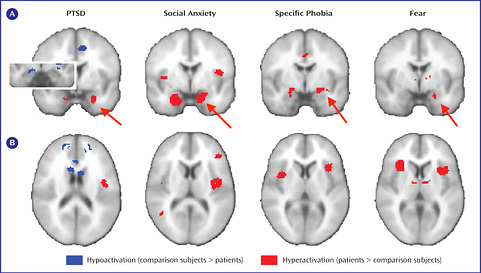
Within our day-to-day activities, it practically feels like this:18
- More stimuli as being relevant to our experience,
- More stimuli being judged as fearful in relation to our experience,
- More energy called upon to meet that fearfully judged stimuli within our experience
Role 2: The Keys To Your Library Are Taken Away (Dissociation)
It is not just our narration that arrives at this conclusion. Other functions also see the energy being drained and begin to conserve in the face of scarcity. Our digestion of our experience is put off to another day. The scary part is that day, can be decades later for some of us as we live outside and beside ourselves.
This too, is the body making a call. You can’t handle the truth, so it takes away the keys to your library until a time of reflection can safely and consistently be presented.
This is called dissociation.
The body believes we are walking across a desert alone without food or water. It is highly unwise at that time to dedicate what is left of our attention and energy to making sense of our situation.
If the threat still remains unsolved, that threat (a predator?) could still be out there. We see this in the visual dominance of loneliness19 and the release of cortisol at a level equal to being punched in the face by a stranger.20
So we run on auto-pilot, far from the fall gravity of our situation.
Again, we can see this in the brain, this time instead of hyper-activation, a reduction in volume of the right superior parietal lobe.212223

What is interesting is this area is associated with non-verbal memory and intelligence24, and more specifically, damage to this area can bring about “...unawareness of the left half of the visual field and even of one’s own body.”25
Coming Home to Oneself is Coming Home to Our Body
Dissociation is not just about living separate to our story, it is about living separate to ourselves. This is interestingly further emphasised via the unique activation of the superior parietal lobe in yoga, breathwork and meditation practitioners.26 Coming home to ourselves is coming home to our body.
I can attest to this also. After about 18 months of Somatic therapy work that involved a yoga practice (and its three parts) as a foundation of my body-led recovery, I started to receive back the keys to the library.
One day, unprompted, a rush of memories surrounding the violent death of my family dog came to my mind’s eye whilst I was in child’s pose.
I’ve disclosed this story in regards to somatic re-integration in the past and will provide a more detailed post in the future on the circumstances leading up to the experience and the aftermath at another time. But suffice it to say, scientific papers with brain imagery can be helpful to read, but the real-world experience of the re-embodiment of your life is an incredible source of motivation to stay on the path but also to widen that path to share with others.
What was hidden for over 24 years was finally revealed, and this was only possible, in my experience, by anchoring my healing journey to a state of downregulation.
I had made countless attempts to make sense of my world to others in conversation, to myself in journaling and to psychologists in the talk therapy hot seat. Sitting opposite a stranger who held a clipboard and peered over the top of their spectacles that befit a meme, I would hold onto the arms of the chair, I would cross my ankles and I would close my eyes tightly as attempts were made at digging up the past. Emotional energy would rise up and a complete lack of capacity of another to hold me in that space, repetitively told my body - we are still in the desert, maybe I’ll give you a morsel of truth, but you aren’t ready (or your social support) for a full meal yet.
The way I describe this experience to others now is by trying to paint a portrait in the dark.
Answering the questions: “Tell me what brings you here?” or “Why do you think they can do it, but you can’t?” is a tall (shame-inducing) order when PTSD is characterised by non-verbal memory recall.27
Once I began to listen to the body and do so in an environment it could trust me to hold, a series of memories that were too heavy to hold slowly dropped back one by one. Surprisingly too, in a largely chronological order as I get closer and closer to meeting myself right here, right now. An awareness breaking through sustained unintended ignorance.
Role 3: You Are Put Up for Wild Adoption (False Idols)
The third role of lost sovereignty that the body takes from us during disorganised states, is that of choosing who’s who in our village.
The body recognises that we have not been able to find consistent safety, we have not been able to work on our development from prior ill-developed states, first attempts at caregiving did not result in what we deserved, and so we are repetitively put up for wild adoption in order to receive the care we deserve and the care we can not provide for ourselves.
In a tribe, stationed in a village, this is an incredibly intelligent evolutionary response to our necessary maturity. Perhaps a parent has passed away or is absent due to war, famine or trade. Does the education process end there? Or can we be adopted by other elders?
Being adopted by kin; uncles, aunties and so forth makes sure that as a collective, our strength is maintained in the face of the challenges that are part and parcel with our entry into this world, whilst still facilitating the transfer of a non-negotiable skillset.
And when I say non-negotiable skillset, I mean it.
As revealed in the last post, infants deprived of touch die and children deprived of a human upbringing regress to a type of Homo-Ferus that is unrecognisable to the human-ness we take for granted.
In short, there is no embedded pre-destinated coming to consciousness available to us as a species; our unique ability to transfer accumulated knowledge across lifetimes such as through cultural and religious practices, books and other art and now in data centres and memory cards, gives unparalleled opportunities for building upon lifetimes. But if we are deprived of this, the physiological, psychological and social implications are immense.
Our fragile elevation above feral is maintained through a marriage of our commitment to the process and the instruction provided by those who came before (relative to their level of attainment). In a clan, this wild adoption pays dividends as the elders receive the bounty from the younger’s maturity, but in the modern urban world, our body struggles to recognise the difference between tribal elders and socially ranked strangers. A recipe for victimisation.
Blinded by a pursuit of the nurturing we require, but absent their investment in our peace and growth, we take refuge from dysregulated states within the warmth of a mother figure and the validation or defence of a father figure.
Considering lost children take being adopted by wild wolves, bears and monkeys over going it alone, we can show compassion to ourselves for hoping for the best when ‘wolves’ in the form of toxic relationships misuse our self-saving lunges for social attachment.
The Body is Trying to Make Us Whole
When the first two towering figures in our life, our very creators, fail to see us out of the nest with sufficient guidance, the body tries to make us whole with other mothers and fathers. As mentioned, this was frequently provided through aunties, uncles and other role models within our tribe. And still effectively does today.
Most of us can recall a football coach, dance instructor, school teacher or a friend’s parent who seemed to have laid the groundwork for who we have become, perhaps largely without us knowing it at the time, but impossible to refute today.
There are long-embedded, gender-specific roles to human making that both draw us to others as children and draw us to the immature as adults. This facilitates our sacred rite of passage from childhood to adulthood whilst at that same time taking upon the responsibility of passing on the necessary library of life to the next generation.
In this era of cultural poverty, a mature commitment to our maturity has transformed into a nice-to-have, and the rite of passage often remains un-walked. Replaced instead by the myriad of temptations made available to our senses.
Is this time really all that different? Aren’t we on a path of progress?
In his justification for an immortal soul28 Socrates supposed that learning is only the process of recollection, the soul having innate wisdom only obscured by the adornment of the body with pleasures instead of a commitment to our maturity that is found in temperance, justice, courage, freedom and truth.29
The Buddha said, sati sabbattha patthiya - mindful awareness recalls intention to all circumstances, and through this awareness, in leaving behind igorance, thirst and attachment, one is liberated from the sense of self and united with the true nature of things.30
Fast forward to Carl Jung who’s calling for a coming to consciousness also liberates man, this time from his regressive longing for the return to the blissful state of infancy, a world dominated by his mother.31
All three examples hold a rite of passage in front of us, the cost of which is a type of cyclical suffering made available to us in our lifetimes and across lifetimes as an opportunity for repair, though we currently meet with ignorance or aversion. Likely our commitment as a species is prone to waxing and waning, but the inbuilt script to be ‘recollected’ seems to always sit within us, waiting patiently for us to come home.
In science, outside of philosophy, religion or psychology, we see the rite of passage from the egocentricity characterising childhood being replaced by empathy as an adult.32
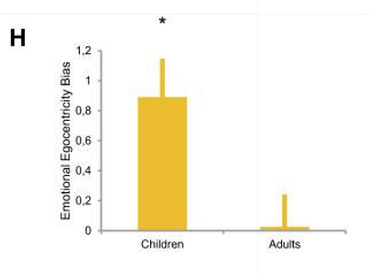
The area of the brain responsible for this egocentricity was noted as reduced activity in the supramarginal gyrus and reduced coupling between it and the dorsal prefrontal cortex. Interestingly this same area overlaps findings of emotional egocentricity within the adult population of previous studies.33
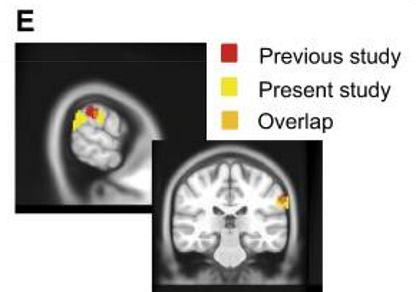
This takes us back to the theme of this post and the original question. Was your emotional experience met with empathy or anxiety? If it was anxiety, we are now starting to see where that self-preservation-focused response comes from, the givers of care still locked in child-like forms within the brain.
The Scripts That Lay Within
If hyper-vigilance, self-soothing and ignorance do not form dense layers over our experience, there are sacred roles awaiting us. Again, science can show this to us outside of the Socratic method or a religious tradition’s holy text.
When a mother looks at her child, the left hippocampus34 and the right amygdala light up. When a father looks at his child, the dorsal prefrontal cortex (remember this when in regards to child/adult egocentric bias?) lights up.35
This ‘limbic’ or emotional regulation favouring by mothers is even evident in non-parent women more than men in response to an infant crying,36 providing an opportunity for healthy wild adoption in scarce times, to prevent role reversal or stunted growth.
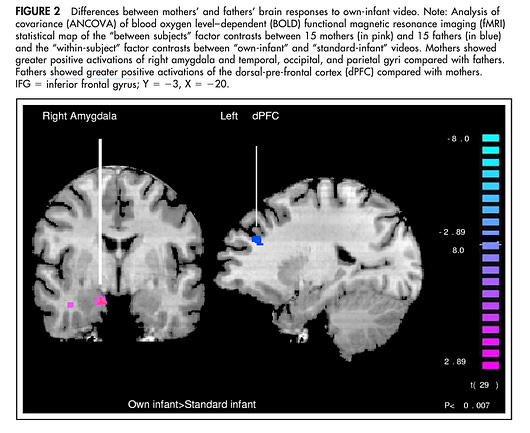
Women are rewarded for this bias with a dousing of oxytocin, the bonding hormone, providing a feel-good for a role fulfilled in precious human making.37
Fathers on the other hand do not receive this oxytocin bounty from limbic activation, instead, he receives it from stimulating play. This is even seen in monkeys with father’s playing with their offspring 20 times more than mothers on average.38 This style of interaction is genetically viewed as so essential that stimulating play (and not sensitive behaviour) is related to childhood attachment security for the father.39 40 He feels good, his child feels looked after.
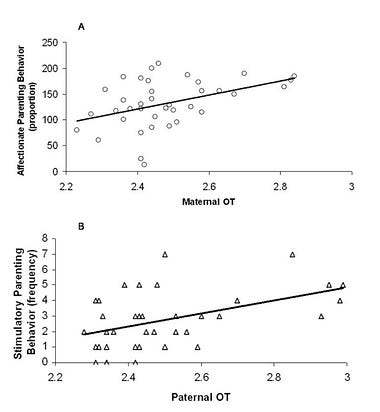
Naturally, one can swing a hammer and miss the nail. Quality of both delivering the service of nurturing and stimulating play varies and oxytocin once again let’s child and parent know if they are on the right track or not.41
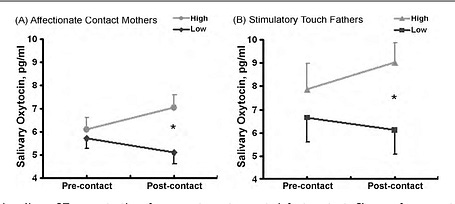
This differential caregiving is not just a bias within the brain and hormones in order to do the right thing to bring about a happy baby. These styles of interacting are passing down the non-negotiable skillsets we touched on earlier, not only for their implementation against life’s stressors but to “...program the infant brain for the next generation of sex-specific emotional expression.”42
The mother’s role is that of emotional regulation, and the father’s role is that of confident separation. The difference in how a child spends time with each parent demonstrates this.434445
When children spend time with their mothers, they prefer states of interaction that are described as, for the most part, low to medium arousal with less frequent peak emotions. Within this engagement, there is mutual gazing, co-vocalisation and ample affectionate touch.
In contrast, when a child spends time with their father, they have more frequent, high peaks of emotional experience that are carried out through physical games and external or object-focused interactions. Instead of continual confirmations of connection, there is an ‘out-there’ bias as the lion cub seeks to explore the expanse of the lion king’s domain.
Hinting at their future roles, female babies tend to have increased eye contact and rhythmical mouthing, whilst male babies tend to have higher reflex startling and more frequent peaks of excitement.
If you have grown up with dogs, you may well have noticed this variance of interaction also between a pet and its male and female owners.
Women carers tend to use nurturing communication, while men carers tend to use more physical contact. Dogs tend to relate to male carers with increased arousal while spending more time with their tail in less stressful positions around women carers.4647
In my own experience, dogs tend to sit with their back to me faster than with females, whilst offering more nose and paw interactions that mimic smothering with females.
An Introduction to Faulty Scripts
Whether it is a canine’s or a human’s bag of tricks that are or aren’t trained, the outcomes are often clear to see. Faulty programming for their future leaves predictable gaps.
The Father Gap
When we colloquially say a father gap, often it corresponds with feelings of self-worth and validation. We see this deeper with father-child interactions contributing to the effectiveness of dialogical negotiation of conflict in adolescence (but not the mother)48 evidenced in social competence and lower aggression in school.
Stimulating play as a child is a key practice ground for risk assessment and boundary setting, seen later in life as assertive social price setting that feedbacks into our own feelings of self-worth.
Recalling the dorsal prefrontal cortex activation when a father looks at his child,49 this area of the brain relates heavily to working memory and decision-making, i.e. executive functioning.50 Since synchrony is central to the development of self-regulation, father absence and lack of sufficient and naturally synchronous same-gender early interactions may disrupt the acquisition of self-regulatory skills and lead to conduct disorder in boys.51 Evidence of the extended duration to repair mother-son relationships may be explained by their neural mismatching.52
The dorsal prefrontal cortex is also implicated in PTSD, with lower volumes53 being seen whilst empoweringly, and to our ammunition for our body-led rescue approach - breathwork has shown5455 increased activation in this specific area.

The Mother Gap
When we colloquially say a mother gap, it often corresponds with the ability to self-regulate our emotional experience. Just as the father gap leads to lower social negotiation skills, the mother gap sets up later life outcomes too, as I shared in a past piece.
For example, maternal aggression was able to predict whether a son completed school or not, and this prediction was mediated by brain changes specifically in the superior frontal gyrus, superior parietal lobule (remember this one in regards to dissociation?) and the supramarginal gyrus (remember this one in regards to child/adult egocentric bias?)56
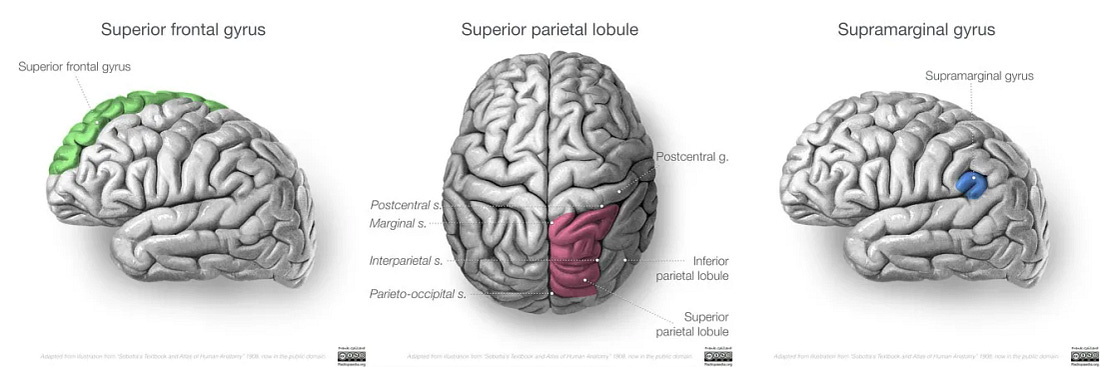
Interestingly, the supramarginal gyrus was the second part of the brain that was identified to be uniquely activated by yoga practitioners.57 Its under-activation and decreased connectivity we flagged as an earlier candidate for un-walked rite of passage for children and adults expressing ego-centric responses.
If the supramarginal gyrus is associated with increased feelings of empathy and overcoming emotional egocentric biases during heightened emotional arousal conditions,5859 its disruption not only provides predictions of lower academic completion but also starts to breed emotionally immature caregivers.
A mother's aggression corrupts a child's brain; that area of the brain corresponds to their own effectiveness of caregiving for their future children, and we see how intergenerational transfer of, at the very least, ill-development and potential trauma can come about.
A Failed First Attempt, But Not Fate
As we start to see just how influential the first attempt at baking the cake of us can be, the early social origins of our disorganised states and its ricochet across time, we are bringing this to awareness not to finger point, but to unravel attempt number 1. Because that is all it is.
When we fall into the habit of believing our experience is our identity, and thus our fate, a cage arises around our potential. That cage is shame, and it, too, hides our truth from us. In not being able to experiment or even see our potential for change, we encourage ingredients that quite readily can bring about not just hyper-vigilance but depressive episodes too.
If we were to experiment with the idea that what you were subject to as a child, the large amount of development that is carried out post-natally and largely outside of your control, loads up tapes into our cassette player of life - what if we changed those tapes?
Would we hear better music, more aligned to our tastes?
In order to work out our musical tapes and preferences, it may well be worthwhile considering what essential instruments put together good music to see if you would like to hold on to the good you hear whilst letting go of the bad and learning to differentiate that difference yourself.
In order to do so, let’s look at three roles that stand opposing our lost sovereignty providing a roadmap to its recovery, and reasoning for its original dispossession.
Role 1: Boundaries as the antidote to fear
Did your parents set appropriate boundaries based on the accumulated attempts of prior generations? Or were you left to trial and fail yourself? Potentially, the results of those experiments falling upon your judgement of character as shame rather than logical outcomes from insufficient support.
Extending upon this further, because sometimes we think of boundaries as simply physical defence of our personal space, and whilst necessary, is a severely limiting definition.
Boundaries can be, for example, delineating for a child the difference between caring about someone and caring for someone.60 One is support the other is responsibility. The latter is, especially when you are a child, likely to be a role reversal for an elder shortfall.
Boundaries can also be, “My needs are still valid even in the face of another person’s disappointment.” That another person’s response of anger, frustration or disapproval may be more accurately a demonstration of their emotional immaturity and not a passing judgment of the validity of your needs as presented in this moment.
This feeds into establishing our castle walls around what we view as belonging to us and its ascribed value, particularly ourselves. And working on our ability to be connected to ourselves and someone else at the same time, in a way that does not require our invalidation, suppression and flexibility to their immaturity.61
Ben Howard, the musician, beautifully describes this balance: “If I was to go my own way, would I have to pass you by?”62
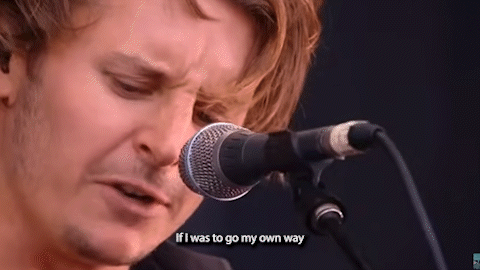
Echoing helpful boundary-building words suggested by my Teacher, “You might like to say, Jason, that you are finding it difficult to love yourself and them at the same time under these current conditions.”
In the absence of boundaries, fear is our last stop, increasingly taking our sovereignty until we choose (if ever) to take back the pilot seat.
Role 2: Internal Exploration as the Antidote to Dissociation
Did your caregivers take time to explore your internal world? And demonstrate, due to the requirement for understanding, synchrony with your experience in order to predict your needs?
This synchrony is a key strategy of connecting non-related parties to a common purpose and why it is so prevalent, from church choirs to army drills. It provides the opportunity to reason about other minds63 and makes it cognitively less demanding and less difficult to do so.64
Mother-infant brain synchrony increases non-verbal communication, quite literally being on the same wavelength,65 with mothers who achieve this harmonious interaction with their infant showing a greater activation in the left hippocampus,66 the area of her emotional regulatory role.
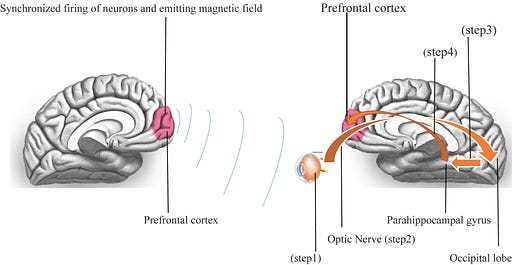
This social cooperation is heavily wired within us. Even babies who have been bounced in synchrony facing another person are more likely to assist when an object was ‘accidentally’ dropped than those who had been bounced out of synchrony with the other person.67
Once again, oxytocin is the dessert for this cascade of increasing connection and ‘other’ understanding with higher amounts being released from more synchronous parenting.68
What we are starting to see is how being in tune with another translates into greater care outcomes as we become more sensitive to their experience.69707172 Just like adults can be separated from children in their egocentricity and adults from other adults, a mother’s brain activation while interacting with her child can reveal what low versus high sensitive parenting as early as 18 months old, looks like.73
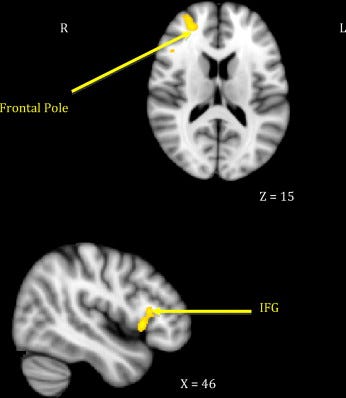
Specifically, the regions that light up are associated with overriding automatic emotional responses, interpreting multiple sources of information to pursue a higher goal and processing other people’s emotions. A second pathway of how well an individual can empathetically understand an ‘other.’
This is where a potential nursery for our second loss of sovereignty, dissociation, begins with our caregiver’s distance from their own truth. The inferior frontal gyrus (IFG) which houses the Broca’s area associated with language, highlights our ability to know another is catapulted by our ability to understand ourselves.
Or as a close friend remarked to me years ago, “We can only go as deep as they have been.”
This may sound fluffy, but more practically, if we do not understand how to listen to our nervous system, make sense of the noise and demonstrate command over it in order to pursue our goals - we are unlikely to be able to understand another or lay down the groundwork for them to do so independently.
Role 3: Trusted Presence as the Antidote to Wild Adoption
Role number 3, could you reliably rely on your caregiver’s social support?
They have met your experience with empathy, sometimes.
They may have taken an interest in your life, sometimes.
They may have presented boundaries clearly, sometimes.
But the difference between sometimes and consistency, is trust.
In the times that they were not able to show up, and without the wider village support you deserved, the slack is picked up by you in the form of maladaptation.
This is seen with
- Attachment security of a 4 month old relating to that childs working memory ability at 14 months.74
- Family stability at 18 months old being able to predict emotional regulation capabilities at 15 years old.75
- High school completion being able to be predicted with an accuracy of 77% based on the quality of their parental care of that person at just 3.5 years old.76
- Parental (not child’s) distress at the child’s age of 15, predicting that child’s mental health diagnosis 3 years later.77
- Time spent with a father between the ages of 11-16 predicting cortisol levels of young adults at 19-227879 and this cortisol reactivity being associated with their feelings of self-worth.80
What Feels Like Fate
It can be confronting to sit within the heaviness of answering some of these questions. Perhaps some happy memories emerged, and perhaps some valid feelings of grief followed in response to the upbringing that you deserved but did not receive.
This unravelling goes a long way in investigating our development, particularly in relation to our parents, and why nature attempted to take over any shortfalls through fear, dissociation and wild adoption.
However, throwing the final blow to the disempowering belief that what we had is what we shall continue to receive involves recognising that the parent-child relationship is the first roadmap we receive for how to give and receive love. Leaving our childhood home may feel like an escape and a fresh start, but that stands in contrast to the fact that our relationship with our parents is projected onto our peers, our partners, our superiors and random passers-by.
Recovering people pleasers like myself will chuckle at the difficulty in sending back a sub-optimal meal at a restaurant to the confusion of non-people pleasers, but from that ‘relating’ we understand that self-sabotage was generated firstly in parent pleasing. In our body’s attempts at self-healing, we continue to put ourselves up for wild adoption for the love and validation we deserve, unfortunately sometimes to a waiter whose sole responsibility in that moment is to serve your needs, yet we have a reduced capacity to even present them.
This spillover effect is seen in parental synchrony between 1-6 months of age, predicting a child’s engagement with their best friend at 3 years.81
This spillover effect is seen in parental sensitivity in early childhood predicting prosocial behaviour at age 9.82
This spillover effect is seen in security of parent-child relationship predicting security of romantic partner relationships 20 years later.83
Scientists explain this phenomenon with fancy graphs such as this:84
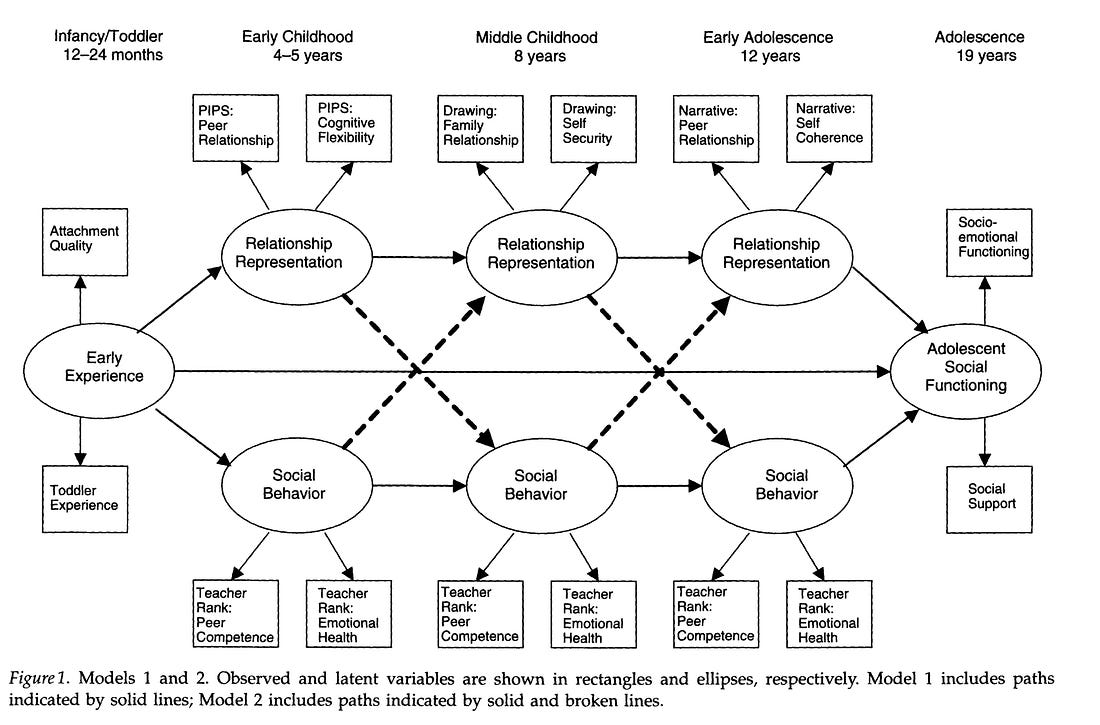
and this:85
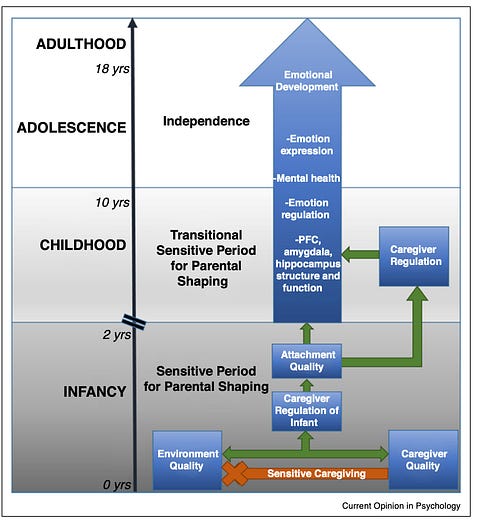
But in practically thinking about how we train a dog to sit, shake, heel - or do not train that dog to sit, shake and heel, we have to balance our expectations surrounding that truth.
If I was not shown healthy boundary setting, have I shown the capacity to present the boundaries I need to?
If my emotional experience was met with anxiety, do I currently meet my emotional experience with empathy or do I meet it with control, anger and/or distraction?
If my internal domain was not of interest to my caregivers, have I prioritised it as a worthwhile endeavour or do I instead look to regulate the emotional experience of another to the declining significance (and awareness) of myself?
In most circumstances, in the absence of a strong mentor replacing faulty scripts without your knowledge, what likely happened is the calcification of these shortfalls (as examples, not limited in our skillset of repair), on each first touch with the rite of passages of life.
Use your own sense of curiosity and examine your emotional experience and the level of social support you received when you had:
- Your first day at school
- Your first friend
- Your first friendship loss
- Your first observation of parental conflict
- Your first observation of parental intimacy
- Your first big consequential mistake
- Your first encounter with puberty
- Your first encounter with death
- Your first encounter with evaluation (for example sports or school exams)
- Your first job
- Your first sexual encounter
- Your first violent encounter
- Your first time letting go of a hobby, a job or a romantic relationship
- Your first alcoholic drink (or similar)
- Your first time leaving home for an extended period
These are just some examples of the irreversible passage from innocence to experience that we as humans are shaped by. Entering with naivety, just as we can black-and-white the response to our emotional experience (empathy or anxiety) we can also black-and-white the result of our one-touch-roadmaps as empowering or disempowering.
Not every event is going to be a win or a recognition of you as someone who makes correct judgments. But in the digestion of the event, were you provided a portal of discovery for the next encounter, or did you default to suppression and behavioural repeat that, as I mentioned, becomes calcified and, with a lack of evidence, builds a shameful belief system of ‘this is me.’
Avoiding the Double Dip
There may be some energy rising up as one-touch-encounters make way for cyclical outcomes, and you grow frustrated at the garden of your upbringing. That is natural, however at this precious moment of getting in touch with our emotions we must test presenting appropriate boundaries quickly, in order to construct a container of our healing.
One of the first tests that may be presented after reading a piece such as this is what I like to call the ‘Double Dip’ phenomenon.
We are faced with awareness as a tonic to our ignorance, and we rightly want to express that externally in order to socially digest the circumstances (empathetic witnessing). With the amount of material on offer and accompanying references, you may be inclined to even press ctrl + P and place hard facts on hard surfaces in front of an obvious candidate for anger: our parents.
What this can look like is:
“Hey, actually, yeah, I have been doing some self-care work, reading more about the importance of childhood development and its impact on adult outcomes. I saw that the security of parental attachment has physiological consequences that can predict real-world outcomes such as some of those I have experienced and that at times I feel ashamed about.”
To which the highest probability response will be:
“What, you think I am a bad....[mother/father]???”
“What, you think I didn’t.... [love you/care for you/do my best]???”
“What, it was a different time, you have.... [resources/interest/ access]???”
It takes someone who has done a lot of self-work to reach the level of emotional maturity to say,
“I loved you. I did my best with what I was confronted by, but I still accept that may not have been enough. Not only do I encourage your work but your work will also benefit my journey, from the shortfalls of my garden of development, because I was a child too once, subject to the same possibilities of ill-care.”
The first, high probability series of responses represents invalidation, re-narration, and calls for role reversal via the calming of their emotional instability. Or, anxiety?
The second, emotionally mature response is not driven by ego but by a commitment to shared goals. Or, empathy?
And so we come full circle, to our original question. When you raised your emotional experience was it met with anxiety or empathy? To expect a different outcome from the same thing is, well, as my Teacher likes to remind me all too often, the definition of insanity.
Instead of insanity, we look for objective milestones that represent our progress and, in doing so, continue to onboard our sovereignty; in contrast to previous times, we may well have sought out the approval of others ill-prepared to offer judgment.
Meeting ourselves where we are today
Adrenal Fatigue: Cortisol Awakening Response
Something that has helped me greatly in untangling the energetic charge around self-care in meeting ourselves where we are, and at times standing alone there, is the ability to identify physiologically where we can massage ourselves back to safety, against the faulty scripts that scream for attention and take our limited energy to recognise and re-write.
One such manner I achieved this in the past was through a test that evaluated my Cortisol Awakening Response (CAR).
When we are operating in a healthy manner, our bodies send us off to sleep high on melatonin and wake us up high on cortisol. Transitioning us out of high and low-energy states. This looks simplistically like the graph below:
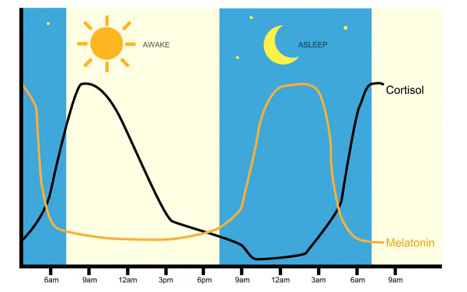
When we have been operating in a hyper-vigilant state for extended periods of time, this wake-up response is ‘blunted’, which looks something like the below, being my results of this CAR test with the accompanying narration of adrenal fatigue.
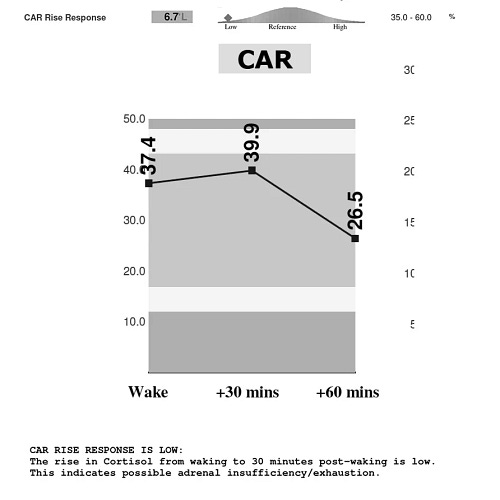
This blunting is shown in wider studies comparing healthy controls, with non-PTSD and PTSD combat veterans, as seen below:86
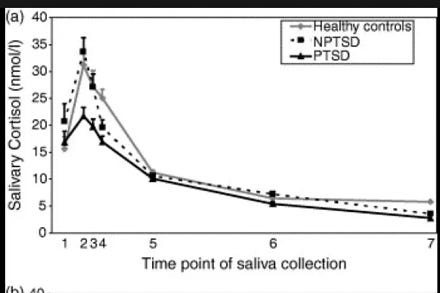
The first time you get results indicating adrenal insufficiency and physiological dysfunction can be confronting. Tangible evidence of what you may assume but hope that may not be true.
But it is also validating and offers an external reference for our re-establishment of boundaries that were likely in prior times violated. If I only give 40%, when I only have 40%, that is my honest contribution of 100% - despite the prior baselines I exported that very likely contributed to my arrival here.
This is very simply an example of meeting us where we are.
What this provides is fewer feelings that can be invalidated, fewer words that can be re-narrated, and fewer consequences that can be ignored. But our goal isn’t for ‘them’ (whoever they are) to meet you where you are, though that could be a by-product; our goal is to take your body vessel into the workshop and, at a distance, go about repairing any stumbled across maladaptations.
What this requires is nothing less than a significant interest in yourself, an internal exploration that, to this date, you may have never opened your eyes to, but is our solution to recovering the keys to your library.
Atrophy of our Emotional Regulation Muscle: The Hippocampus
Another baseline, or checklist within your garage for your bodily vessel, is the area of the brain that dominates emotional regulation, the hippocampus.
People with a blunted CAR have been shown to also have a potential for a lower hippocampus volume,87 and brain scans of PTSD subjects show what this visually looks like, a grape that has been stepped on.888990
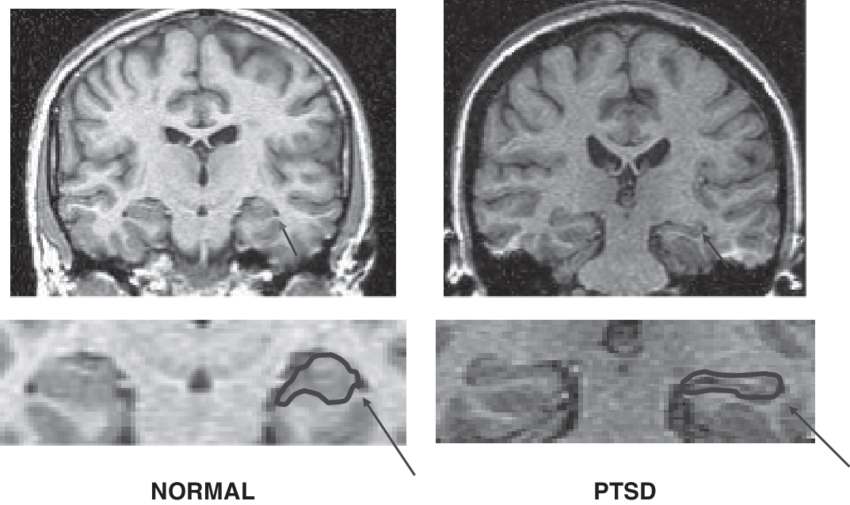
Instead of making wine, a squashed hippocampus triggers a higher release of cortisol,91 is correlated with lower social ranking,9293 reduces our ability to inhibit behaviour (agency) and has even been suggested as being the mediator of personality types.94 Instead of, ‘Jason is a sensitive, reactive, or anxious person.’ Words I’ve been externally described as since a young child - what if my increased reactivity to life stressors was a result of a lower hippocampal volume?9596
In this case, we see the hippocampus as a muscle, like a bicep without dumbbells, reducing our ability to carry 12 shopping bags from the car inside. If I began working out this muscle, and it increased, would those one-word labels prove false - and if so, who would I then be? What would that feel like?
Despite hippocampus ‘atrophy’ being a smoking gun for emotional dysregulation or disorganised states,979899 not once did a contemporary health professional amongst the blood tests, CT scans, and DSM-5100 diagnosis suggest a ‘hippocampal work-out.’
Yet, hippocampal volumes have been shown to be up to 26% lower in PTSD101 and “Smaller hippocampal volumes are one of the most consistent findings in neuroimaging studies of post-traumatic stress disorder.” 102103104105
It is not just PTSD, hippocampal volumes are 19% lower in depression106107 and reduced by an equal amount in states of dissociation.108
Lower hippocampal volumes, in particular the left hippocampus (remember this in regards to a mother’s sensitivity?) are also associated with child anxiety scores.109
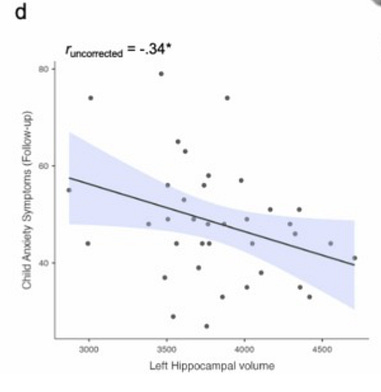
The Early Social Origins of Emotional Regulation
Meeting ourselves with the reality that our PTSD, depression and dissociation diagnosis may well also mean the confronting truth our emotional regulator muscle is only 4/5 the size of our healthy community members, perhaps this is also a viable candidate to understand the early social origins of. Is this something that has prediction power from post-natal care? Unsurprisingly, yes.
The hippocampus size of a child at 13 years can be predicted by their parental support as early as 4 years old.110111112113114 Whilst the quality of maternal caregiving from a similar age showing clear, and diverging, trajectories of total hippocampal volume and this related to better emotional regulation of that child when they reached adolescence.115116
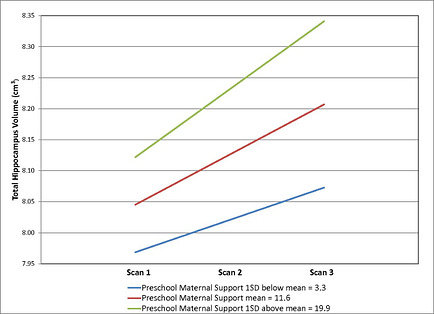
Just like maternal support in preschool is a variable factor, so too are the environments in which this occurs. Children who grow up in rural environments, on average tend to have larger left hippocampal volumes.117 And to risk sounding like a broken record, that is associated with stronger emotional regulation capabilities.
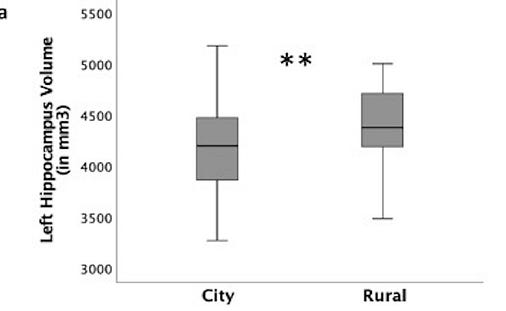
The PTSD Pathway of Non-Overcoming
Finding the flexibility that exists in our physiology, be it growing up in a village versus a metropolis or having synchronously biased mother and father versus not, I hope, injects a heavy dose of curiosity into your existence. In this boundary-less world, that can mean a rabbit hole or two at 2 am in the morning.
To prevent this and to provide a container for our healing, we have the opportunity to stand on the shoulders of others. One such opportunity is offered by a PTSD pathway as shared by Dutch psychiatrist Bessel van der Kolk.118
That pathway is the hippocampus as our emotional regulator and library of memories (covered above), the amygdala as the threat detector, and the Broca’s area responsible for our verbal hero story.
The Amygdala, the Threat Detector
The right amygdala has been noted as being hyperactive in PTSD119 and variances are correlated with the severity of PTSD symptoms experienced by patients.120
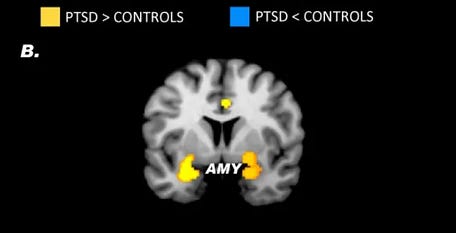
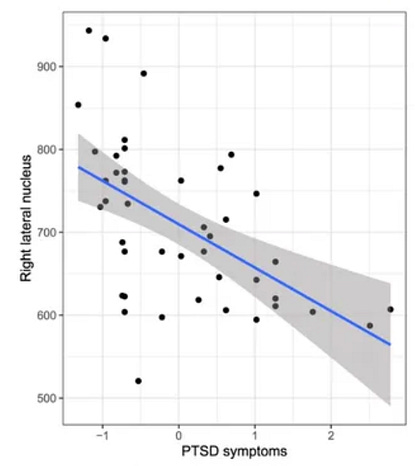
The right amygdala is also hyper-active in depression,121122123 which may surprise people who have never suffered from that state, but for those who have, the lost hope is not about a strength of smile on any given day, it is about the world as socially supporting ally or socially defeating enemy. Social defeat and the perpetrators of that firmly form a threat to be detected.
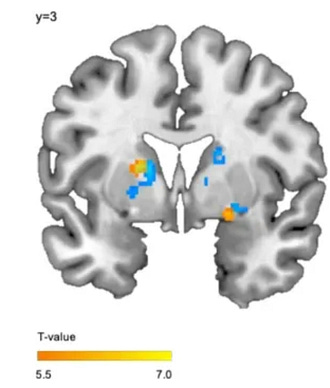
It is enlarged in autism,124 is associated with perceived stress125126127 and has a flow-on effect of producing less sensitive maternal caregiving.128 The possibility of intergenerational transmission of dysregulated states receives another clue.

Just as the hippocampus showed up with an early association of dysregulation (not just its later diagnosis) - so too is the case for the amygdala, with caregiving and context variances.
An insecure attachment to parents at 18 months old is able to predict greater amygdala volumes some 20 years later.129130 The gap between those dates likely felt as experience equating to character, though this finding suggests instead that our physiology is making rational responses to irrational demands.
Contextually, urban environments have been shown to increase activation of the amygdala compared to natural environments131 in simple comparisons of taking a walk.

Deeper investigations into the urban environment our great-grandparents and before could never possibly dream of, we find that, even if we choose to not walk all day in the traffic, the air we breathe is less under our discretion.
In one study conducted in northwest Italy, only the site situated in a mountain national park region did not consistently register endocrine-disrupting levels of air pollution.132
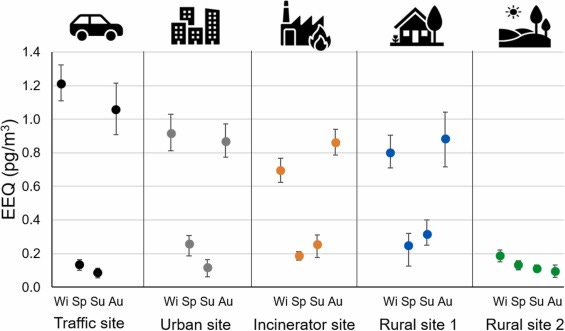
A simple screenshot of air quality that I took on 4th February 2025 (available via the Apple Weather app) whilst writing this post seems to quickly confirm this. Unless you live in the mountains or alternatively by the sea, which tends to not be where major metropolitan regions (jobs) are situated, poor air quality regions were clearly evident in north-west Italy, but also huge swathes of north-west Europe.
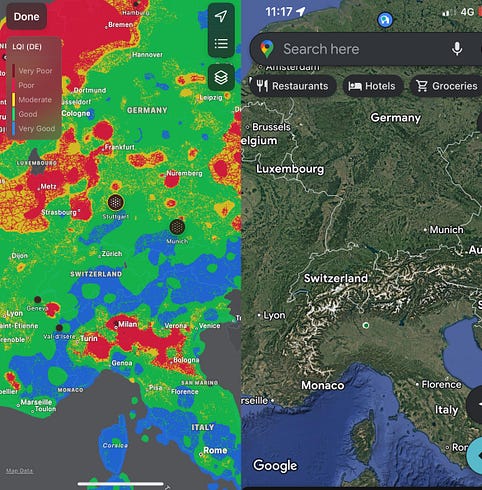
This endocrine-disrupting level of air pollution and other endocrine disruptors like it in the form of pesticides, pharmaceuticals and phytoestrogens activate the amygdala via at the very least, the estrogen receptor beta pathway.133134135136 This estrogen receptor disruption has been linked to anxiety, depression and hyper-vigilant behaviours, especially so in women.137
Other studies have also shown right amygdala activation variances between those living in rural versus urban environments, being higher in urban environments.138
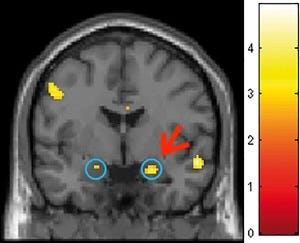
And a gradual scaling up of activation as we split from rural, town and city dwellers in response to stress.139
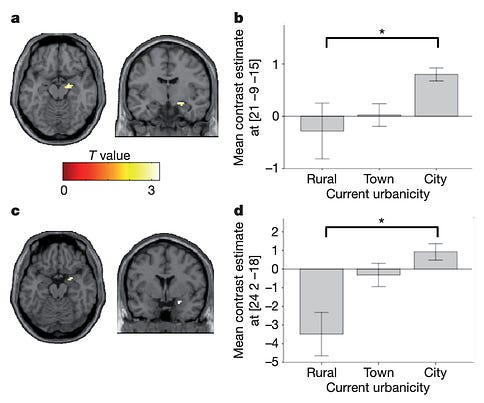
One has to question what type of pressure our new style of living, that since 2007140 is the majority of us, has on our primitive nervous system.
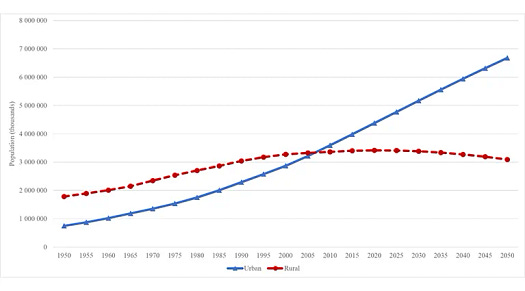
In nature, mass extinction events related to over-population and mediated at least in part by adrenal fatigue have been seen in deer, rabbits and rats.141 I would suggest the phrase, ‘rational responses to irrational demands’ may suit our newfound circumstances as well.
A Silent Terror, The Broca’s Area
The final member of our trifecta of physiological self-investigation in meeting ourselves where we are is the Broca’a area. The Broca’s area is ‘markedly decreased’ in PTSD142143144 and adds to our understanding of PTSD and disorganised states within the body as a silent terror, or as the saying goes ‘Trauma doesn’t come back as a memory; it comes back as a reaction.’145
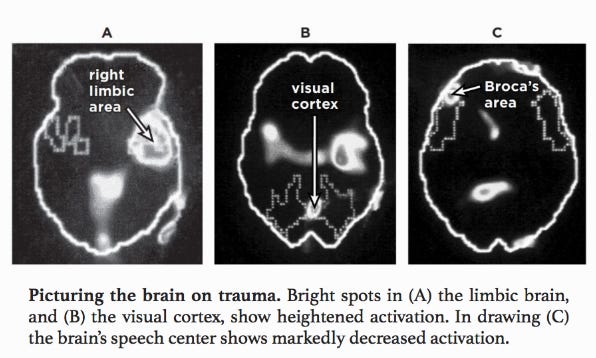
Continuing with our compassionate ‘DNA in a petri-dish’ approach to our contextual demands, we see that in the variability of reading scores of children at age 5, the only neural-environmental variable that survived was that of socioeconomic status and the left inferior frontal gyrus (IFG), a region that once again, includes the Broca’a area. The graph below shows the strength of this correlation.146
One of the reasons suggested in the past for the connection between socio-economic status and poor language development was the ‘30 million word gap,’147 which was discovered to be the distance between well-off and poorer households, in the number of words a child was exposed to growing up.
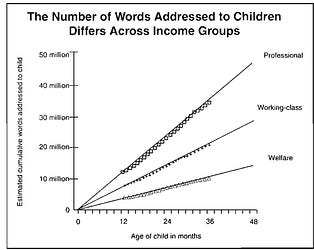
Accumulating evidence of the intergenerational transferability of dysregulation, the inferior frontal gyrus is also a key marker of the sensitive responsiveness of a mother to her child.148 Along with the right frontal pole, it appears to provide support for the ability to understand another’s perspective and pain.149150
MIT scientists, however, were able to fully reverse this socio-economic disadvantage, not with a bucket full of cash, but with conversational turns. How frequently the speaker changed in a conversation with a child, which was facilitated by significant activation of the Broca’s area.151
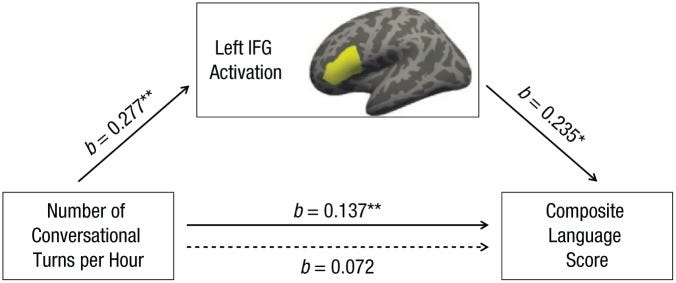
Not to leave out our urbanisation variant, children who play outdoors use more language and more complex language,152 with language development advancements seen especially with those able to play independently outside.153154155 One aspect that seemed to strongly buffer this positive growth story is safety.
Being in a state of safety is not only beneficial for childhood development, it likely marks the difference between recovery and persistent PTSD, and is why I say that downregulation is the anchor to our return to functionality and beyond.
What a Break-Down in the PTSD Pathway Looks Like
If we were to goal-seek resolution involving the threat detector (amygdala), emotional regulator (hippocampus) and narrator of our hero story (Broca’s area), we would be looking for low amygdala reactivity, strong hippocampus and an active Broca’s area. Naturally, this is not definitive, but drawing that into focus, the spillover effects to other down-regulating, fear-extinguishing pathways are also supported.
When this pathway breaks down by an over-active amygdala through hyper-vigilance (non-safety), it stops short the flow of overcoming and this can be felt in our lived experience in diverse ways. The interesting case study of a couple involved in the exact same car crash demonstrates this. One individual, when triggered by re-experiencing their trauma, showed hyper-activation, whilst the second individual showed hypo-activation.156 From near total activation to almost complete de-activation, all from the same encounter.
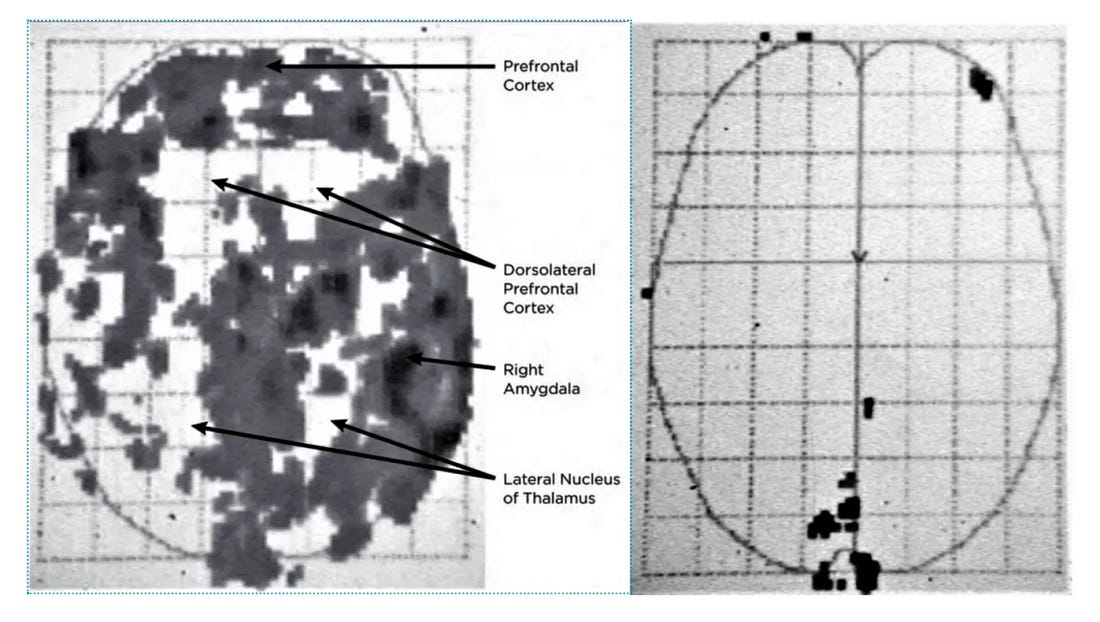
This is not confined to a polar response from mentally returning to the scene of our trauma, we can feel this more broadly with un-discharged traumatic stress during our day. Some moments move us to a shutdown response, and other moments lead us to complete panic. In other words, we are in a disorganised state. That is a state, not fate.
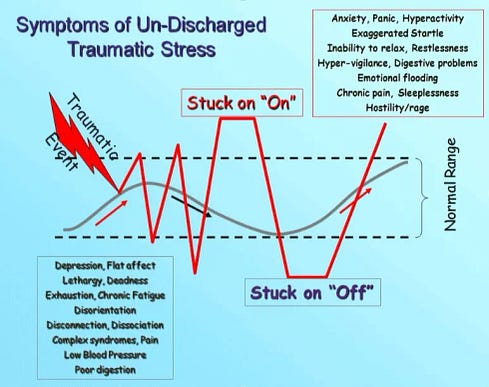
If we commit to re-organising this pathway, taking the role of both the marble and the sculptor, what would we feel like? Even if PTSD is not on your list of diagnoses, to understand this functioning within your body if you are prone to anxiety, depression and difficulty maintaining a settled state - is to prove an opportunity for repair. If we were to allow what does not serve us to fall away and if we allow what does serve us to be added, what type of person could we become?
A Commitment to Re-Building Ourselves
Breaking the Cycle
We see this fear-extinction pathway as useful to understanding the making of our current dis-organised states of anxiety, depression, PTSD and/or dissociation but the power that sits behind the original question of empathy versus anxiety is revealed yet again as this is the same pathway corruption that corresponds to the sensitivity of care.
More sensitive mothers show a lower activation of the right amygdala, a higher activation in the left hippocampus, and increased activation in the inferior frontal gyrus that houses the Broca’s area.157
What we can’t avoid seeing in that light is the beginning of intergenerational human-making deficits. One generation has suffered context, caregiving and/or consequential encounters becomes a viable candidate for the maladaptation of human-making of the next.
We can’t knock down the cities.
We can’t go back to our childhood.
We can’t (and shouldn’t) pretend disempowering events never happened.
But we can commit to re-building ourselves and, in doing so, become the agent of our own rescue.
Whilst there are likely many ways to go about that re-building process, I personally have yet to find a more effective approach than the three-pronged practice of yoga, being body-work, breath-work and meditation.
Trauma specialist Bessel van der Kolk adding, “Our studies show that yoga is equally as beneficial—or more beneficial—than the best possible medications in alleviating traumatic stress symptoms.”158
Colloquially, why this is likely one of the more successful methods and has proved its worth being passed down thousands of years, is because yoga offers the ability to come home to ourselves. It offers a roadmap to:
- Work on the assumption the body is trying to save you
- Learn to listen to the way it is trying to do that
- Anchor the communication flow to a state of downregulation
So what does that look like within the discoveries we have so far unearthed?
What if the World Was Less Fearful? The Amygdala
Considering the amygdala is prone to being the trigger switch for turning off the downstream digestion and over-coming resources, that is likely a decent place to start.
More generally, a 12-week yoga course has shown reduced activity of the right amygdala,159 with a significant effect over time seen via a reduction of volume of the right amygdala in those partaking in yoga.160
Diving deeper, the relationship between the amygdala and breathing has only been recently explored, with fascinating cases where stimulation of the right amygdala has caused a near cessation of breathing.161162
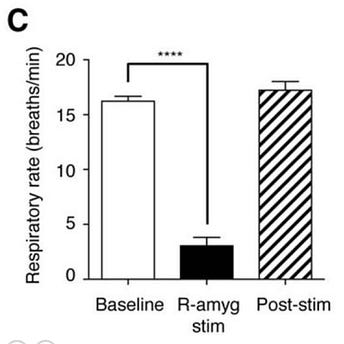
If your experience of persistent hyper-vigilance is anything like mine, you may well remember times you stand up from your desk and feel light-headed or take a big gulp of air as it appears you’d almost forgotten how to breathe. Self-suffocating for hours on end in a shallow chest breath while finger-tapping in forward neck posture.
At its opposing dysregulated state, anticipation anxiety increases our respiratory rate. The scale of increase is correlated with the severity of the anxiety experienced by the individual. This increase in respiration is believed to be driven by an unconscious activation of the amygdala, accompanied by an uncertain feeling before our cognitive processes are even beginning to put a label on the energetic state as an emotion.163164
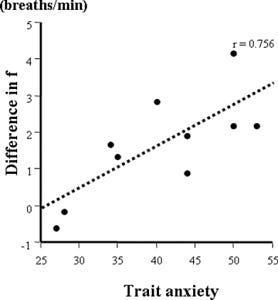
This fear-driven highway, thankfully, is open to our interjection, with the breath able to re-synchronise activity in the amygdala165 and other stress-related activations such as heart rate,166 in particular through nasal breathing which is considered an “...entry point to the limbic brain.”167
Active breathing techniques such as vibratory breathing espoused in the form of Voo by Peter Levine168, and seen in popular press such as British Vogue169 is a spin on the age old Aum (or Om) with its use showing significant de-activation of the right amygdala.170
It is believed the pathway activated through this slow, deep, vibration-focused breathing is that of the vagus nerve, which is increasingly seen as an area of focus in PTSD treatment via Vagus Nerve Stimulation implants.171172 It is nice to know, though, that surgery-free opportunities such as breathwork offer opportunities in the safety of our own homes for self-care.
Further emphasising the strength of this technique, breathwork exercises with similar vibratory focus have been shown to be even more effective than sleep at enhancing the parasympathetic nervous system (rest, digest, play and procreate) and slowing down the sympathetic nervous system (fight or flight).173
In regards to the mindfulness component of yoga, a per-hour correlation between practising mindfulness and reductions in amygdala reactivity174175 has been discovered. With an even greater bang for your buck from a per-minute correlation evident in compassion-based meditators.176
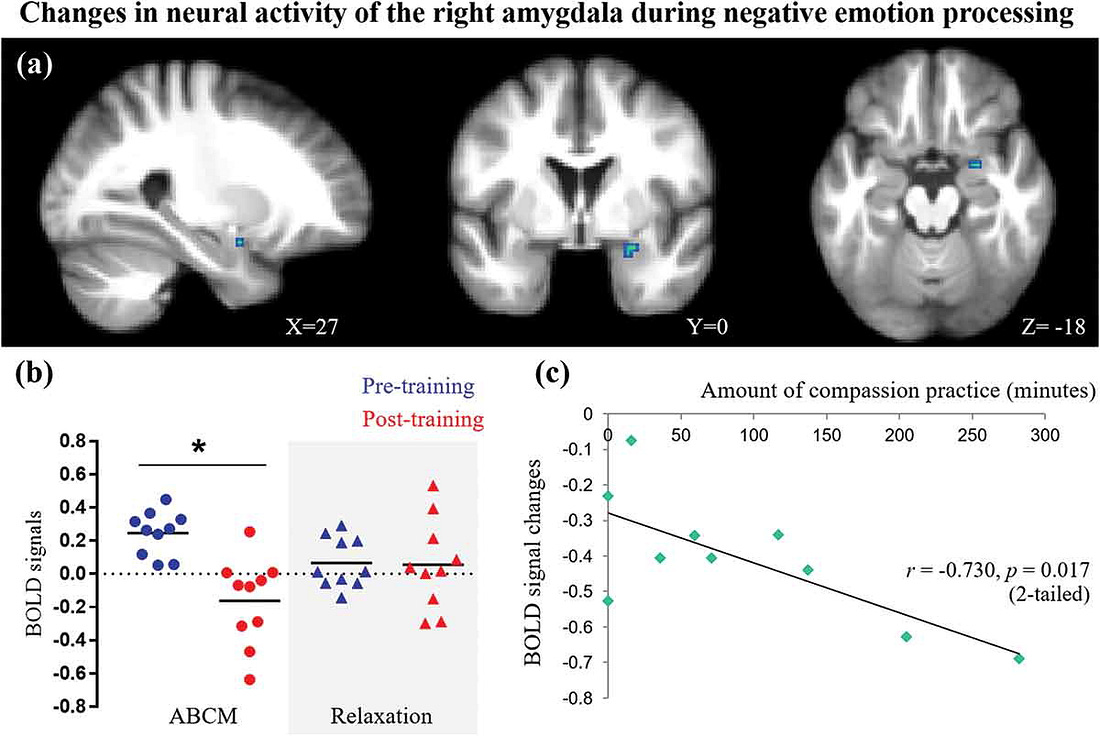
This is one of the reasons why we practice loving-kindness (Metta) meditations with our meditation Monday exercises.
If our DNA has been subjected to sub-par conditions, and we are still unlocking our cage of shame, sometimes it is useful to see some aspirational human forms. One such example is Alex Honnold. Alex is a rock climber who shows zero activation in his amygdala.177 We are unlikely to reach this level of non-reactivity in our lifetime, but it is wonderful to see the opposite end of our human clay once again, and we can use that as a carrot to keep us dedicated to our practice.
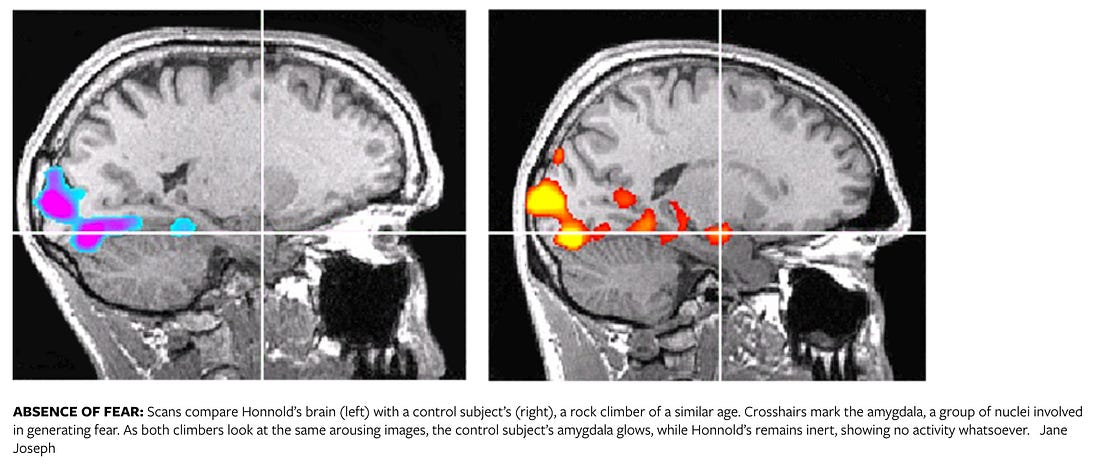
What if You Flexed Your Emotional Regulator Muscle? The Hippocampus
It is all well and good to be less fearful and less reactive to our world where the only constant is change, but when emotional experiences do arise, we would like to be able to process them. Noting that our hippocampus may be in a state of atrophy whereby volume differences in PTSD, depression and dissociation can be up to 26%, it is empowering to discover that meditators, in contrast, have shown a 15% increase above healthy controls.178179180 Which is worth noting represents significant elasticity.
This volume increase is again positively correlated with per hour of yoga practice.181182183184185186187
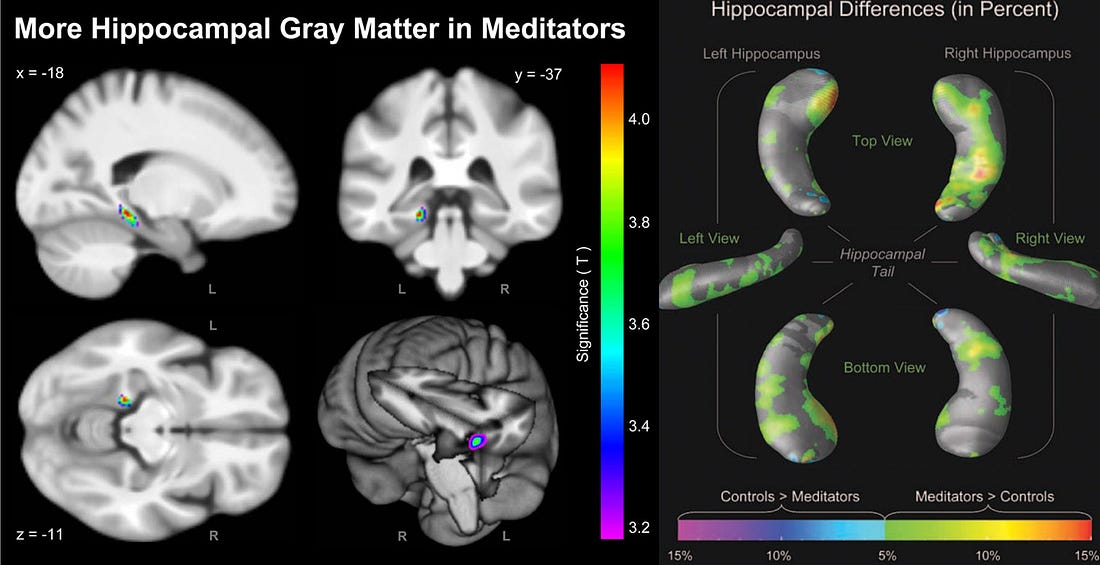
However, it is not just its size that we are looking for. We are seeking for it to be given the opportunity to do what it does best, and as of December 2024, the significant impact that breathing has on the hippocampus functionality has been uncovered.
It was not known how the hippocampus entered into its sleep state of memory processing. Are these oscillations inherently arising? Or does it attach to another rhythm within the body? As it turns out, it is the latter, and that rhythm is our breathing.188
The breath imposes an independent rhythm on the hippocampus189 and enables it to make sense of our experiences using pathways that are otherwise occupied during our waking hours.190 Interestingly, however, meditation practitioners have shown to be able to tap into these processes.191
Breathwork appears to be the gateway to this possibility as we find that nasal breathing strongly modulates hippocampal activity192193 and there are increases in neuroplasticity transmitters when using the four parts of the breath (in, hold, out, hold).194195 The area in particular that produces this is the oxygen-deprived state after exhale, which in some traditions, such as the Aum breath, is held as a sacred interaction with the universe.196
My ears always prick up in moments like this where sacred practice crosses over with scientific significance, and it is also why we perform the Aum breath in our Monday meditation.
What if Your Past Became Your Hero Story: The Broca’s Area
In contrast to the “markedly decreased” activation within PTSD subjects, yoga practitioners show increased connectivity.197 12 weeks of yoga has also shown to be as effective as the gold standard of memory enhancement training198 with activation of the left IFG (where the Broca’s area is situated) correlated with improved verbal memory.
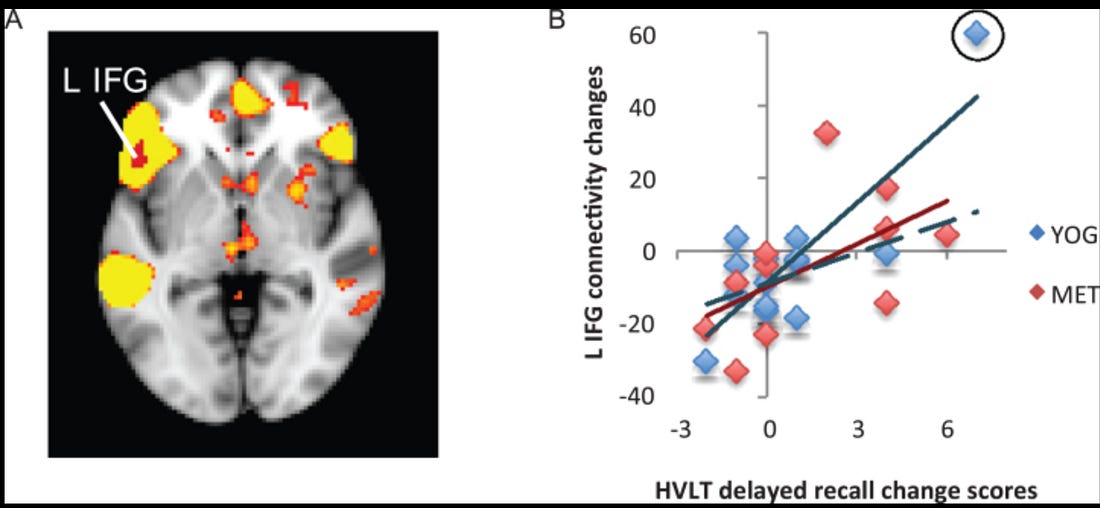
Breaking down the practice, mantra199200201 and compassion-based meditators202203 have shown hyper-activation in the IFG. Whilst breathwork has received some encouragingly supporting data, just this year. A pre-print of a study released on 14 January 2025 said:
“Our study has demonstrated for the first time that lungs may function to shape Broca’s area as the speaking center, and this is consistent with the recent work of a lung–brain axis.”204
Providing further evidence to my Teacher’s advice that the breath is the energy current of our life, and why I press on about its significance in our practice. But that wasn’t always my opinion, and it may be confusing to you if it is currently new.
When I first heard ‘breath-work,’ I thought it was for elephant-pattern pant-wearing hippies that had been sucked into a cult. I came to it very slowly and cautiously, but as I did, subjectively, I believe that it is the greatest pound-for-pound tool we have in our healing toolkit. Seeing how influential its reach is from the amygdala, to the hippocampus and the Broca’s area - it offers a highly accessible first step to a body-led approach to our return to functionality.
Rebuilding the Castle Walls
The Two Parts of Fear and Overcoming
So is that it? If I head off to the mountains and come home to my body, will all my worries fade away? As my Teacher has always reminded me, we can sit in a cave for 11 years, but it only takes one step into our childhood home to take us back to where we started. It may not be that severe, but there is science to the silliness.
The reason for that is durable over-coming on an objective basis, must be able to withstand the test of not being away from that which may have caused us stress, ill-development or worse. Otherwise, we only find safety by avoidance. A coping mechanism we may have lent on significantly during our time of disempowerment.
What is important to understand is that if we are going to achieve sustained recovery, there are two sides to fear and overcoming.
When a fear is established, a memory of that encounter is acquired.
“Ouch, I touched the stove, and now my body doesn't want me to even enter the kitchen...”
To overcome that fear, we re-enter the kitchen, operate the stove safely, and enjoy our meal at the dining room table.
But the fear does not go away, we acquire a new memory, a memory of extinguishing the fear, that stands in contrast to the first memory. But our ability to recall the fear extinction memory is not a given. This inability to recall our overcoming is so vital to our return to functionality, that it has been suggested as the differentiator between PTSD sufferers and trauma-exposed controls. That is, fear extinction learning did not differ, it was the ability to recall that fear extinction that led to PTSD even when the threat has now passed.205206207
This recall is influenced via our suggested pathway once again with hyperactivation of fear expression via the amygdala and hypoactivation of fear extinction memory networks via the hippocampus208 impeding proper memory and emotional processing. Providing further impetus to training those areas through a body-led practice.
But it is important to remember that this is not a sign of us being broken, this is a sign of the body trying to save us, as it always does. If the body is currently in a disorganised state, it starts to browse our filing cabinet of bad experiences, in an attempt to make sense of a present that is punctuated by hyper-vigilance. To not do so, would require us to re-eat the poison berry and re-walk off the cliff edge we didn't see.
The body stores these previous maps and double verifies against current threats in this hyper-vigilant state. We feel this as the re-emergence of flashbacks. The critical role of hormones in this process,209 and our vulnerability to non-nourishing environments leads to women with PTSD having more flashbacks roughly a week after ovulation due to lower levels of estrogen in the body at this time of their cycle.210211 This sex hormone variance is believed to be implicated in the heightened risk of women suffering from PTSD, being twice as likely to be diagnosed than men.212
Balancing hormones is incredibly important, but I would like to provide a couple more examples of contexts that, without our noticing, have turned from supporting to subtracting. Once again, these examples are probably unlikely to have been presented by contemporary practitioners despite the knowledge we possess of their influence.
How to Give a Healthy Animal Anxiety in One Easy Step
Just as hippocampal volumes were never discussed despite their stand our irregularity in disorganised states, the gut microbiome is another such example.
Scientists are able to transfer anxiety, even specifically social anxiety by taking the bacteria from the gut of an affected animal and putting it in an otherwise healthy animal.213 The same can be done with depression.214
Engineering mental illness from gut dysbiosis makes sense when we understand that:
“Interestingly, both preclinical and clinical evidence shows a positive correlation between gut dysbiosis and the pathogenesis and progression of neuropsychiatric disorders. Long-term gut dysbiosis leads to overstimulation of hypothalamic–pituitary–adrenal (HPA) axis and the neuroimmune system, along with altered neurotransmitter levels, resulting in dysfunctional signal transduction, inflammation, increased oxidative stress, mitochondrial dysfunction, and neuronal death.”215
In the case of depression, we get diagrams such as this demonstrating a similar thought line:216
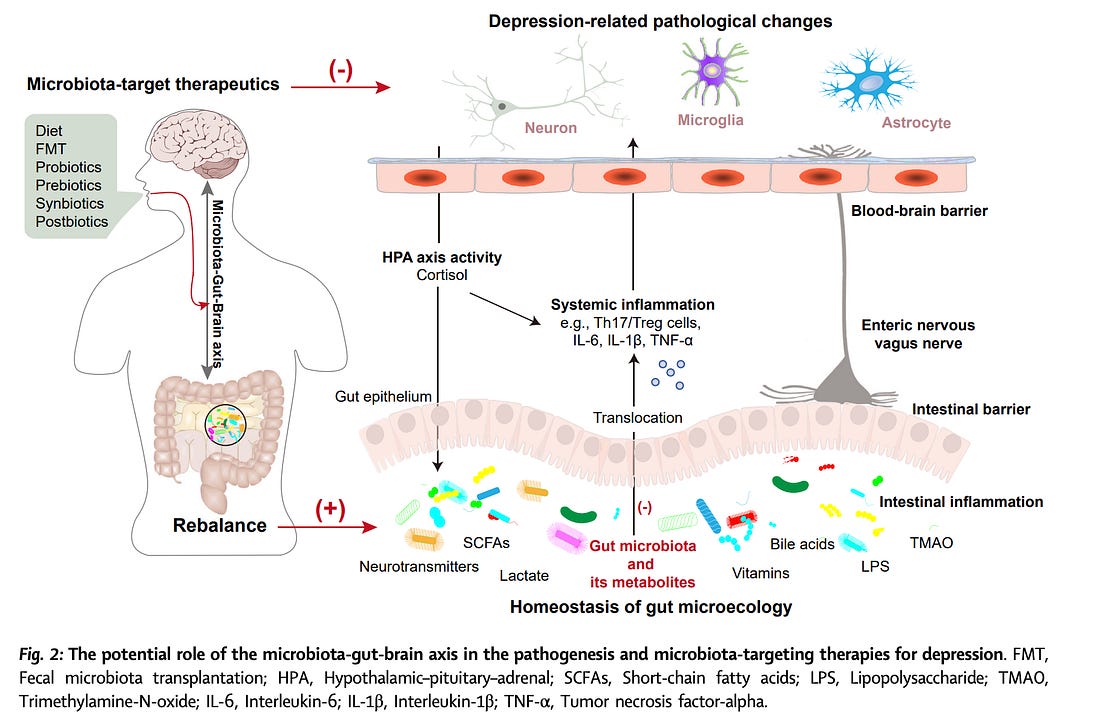
Separately, in dissociation, there was the curious case of a man resistant to anti-depressants, anti-psychotics and anti-epileptic medicines, but curing a Helicobacter Pylori infection in his stomach brought about relief.217
Knowing this, I’m particularly passionate about providing examples where we are a frog in a pot and being told to pipe down. What type of changes have occurred recently that mimic our removal from the refuge of a mountain, sea or forest and placed within a stressful environment, this time our body vessel?
Candidate 1: Magnesium
One such example is the nutrient exhaustion of our food, shown below between the period of 1914 and 2018,218 with the first date roughly equating to when my great-grandparents were born.
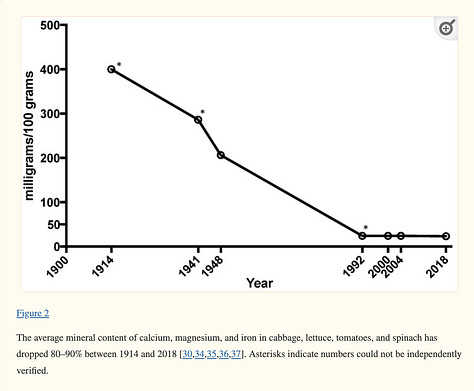
Pulling out just one example, magnesium, we see in a shorter time frame its reduction from 1940 to 1991 in meat and vegetables of 15% and 24% respectively,219 a period roughly equivalent to when my grandparents were heading to school and to just after I was born.
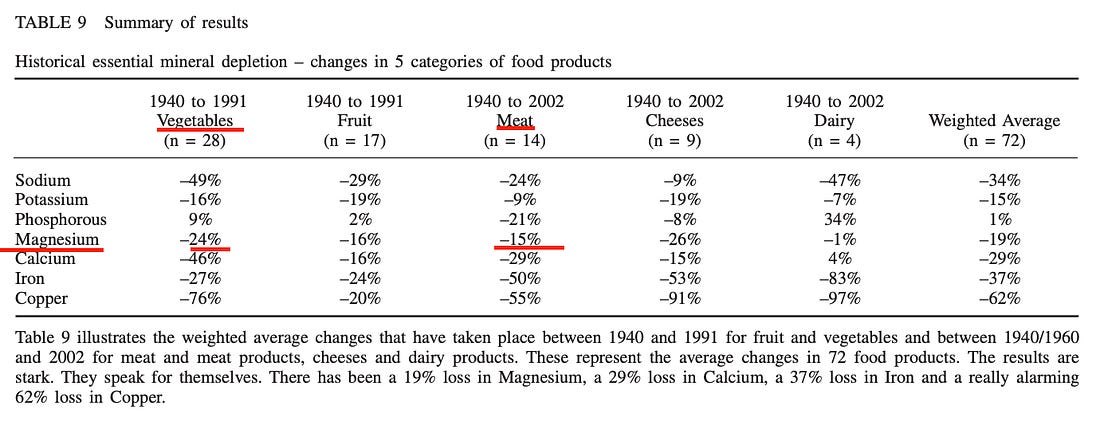
Perhaps, like me, you are wondering what happens when we deprive our bodies of magnesium, such as is the case with a side by side comparison of my great-grandparent’s dinner plate and our own. Would this be an environment that would support fear extinction recall or potentially suppress it? And in its suppression, is our nervous system encouraging a re-visit of the back catalogue of bad outcomes?
As it turns out, low levels of magnesium lead to hyper-emotionality,220 compromise the synthesis of vitamin D221 (the levels of which are inversely associated with anxiety risk222) and have been shown to be independently associated with depressive symptoms.223
Ok then, next question, what happens if we were to supplement with magnesium?
One meta-study covering 325 individuals revealed a significant decline in depression scores after a magnesium supplement intervention;224 another found it has neuroprotective benefits,225 and another showed the connection between low magnesium and oxidative stress that is caused by an influx of calcium,226 that oxidative stress being the flint to the fire of our anxious states.227
Candidate 2: Omega 3
Another change has been the reduction of omega 3. A similarly scary-looking graph demonstrates a fall in omega 3 composition throughout the 20th century. A primary influence of that fall is believed to be the out-competing effect of seed oils, in particular, soybean oil, with its use in cooking increasing 1000-fold from 1909 to 1999.228
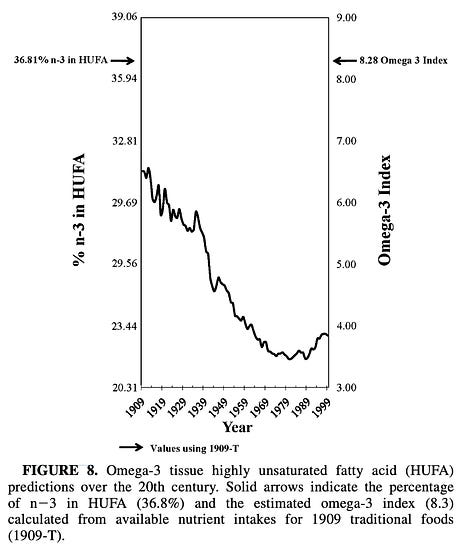
Soybean oil is rich in linoleic acid and omega-6 fatty acids which compete with omega 3 processes,229 and not only does it have an opposite effect of, for example, testosterone levels, it prevents omega 3 from doing its job as a testosterone promoter.230
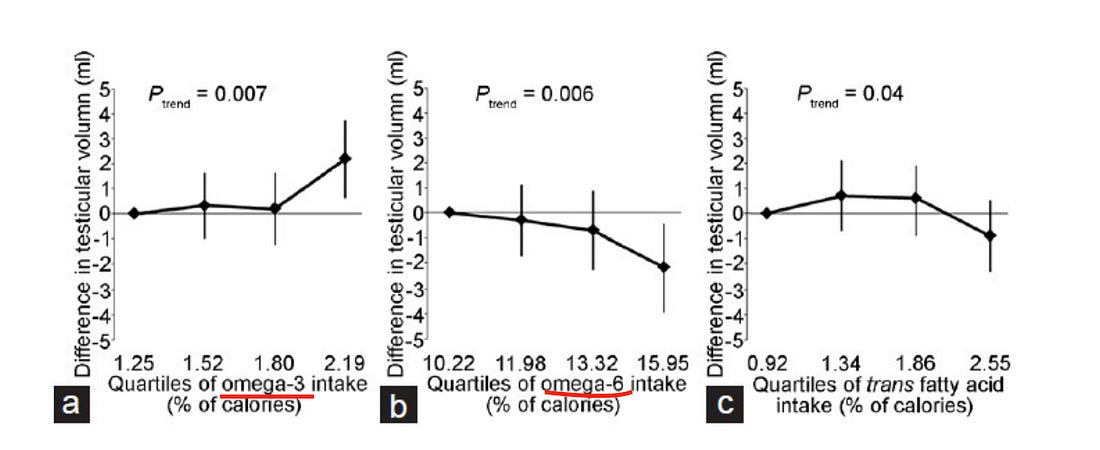
The same negative correlation exists with cognition function with a significant positive correlation between serum omega-3 levels and a significant negative correlation between serum omega-6 levels and cognitive function.231
Another notable side-effect of this shortfall is toxin removal, which may well relate to the aforementioned cognitive abilities. We have 500ml (~17oz) of fluid to remove from our brain daily232 and if this system is disrupted, we get depression.233 Omega 3 plays a significant role in the removal of these toxins in the brain.234235
Candidate 3: Vitamin B
Vitamin B12 deficiency was traditionally associated with poverty.236
A study in Ethiopia showed that 34% of students had B12 deficiency, and this was associated with not consuming animal products.237
A study in India found 31% of Indian adolescents were B12 deficient,238 with some studies suggesting population-wide deficiencies of up to 75%, and a statistically significant association to vegetarian diets.239
However, the rise of non-animal food preferences has made this more widespread even amongst young, wealthy populations.240241
Why should we care about this deficiency? Aside from the intergenerational risk,242243244 because, once again, you get depression.245
Why do we get depression or other disorganised states?
Firstly, it is a one-way trip to gut dysbiosis, as 80% of your gut bacteria need B12 for their metabolic reactions.246
Secondly, B12 is involved in the protection of our nerves, via myelin sheaths that sit over the top of nerves and ensure smooth transmission of messages in the body.247248 When this protection is compromised, you get anxiety and depression249
Furthermore; people diagnosed with autism have 50% of the B12 levels of non-diagnosed people,250 children low in B12 show lower intelligence scores,251 and B12 have been implicated in general weakness and pain.252
What I like to continually reference, is what has changed in the last couple of generations that has turned from supportive to subtracting and vitamin B consumption is one of them. If you asked your grandparents what they ate as a child they probably would tell (or did tell) stories of eating liver, kidney, heart and so forth. Whilst a lot of that was likely on economic grounds as well, these organs are packed with vitamin B and not just B12.
Vitamin B1 deficiency has been shown to deprive the limbic (emotional) brain, of oxygen:
“....emotional and stress reflexes of the autonomic nervous system are stimulated and exaggerated, producing symptoms often diagnosed as psychosomatic disease.”253
And depriving the brain of oxygen is a one-way ticket to anxiety and depression.254
Another incredible example, in my opinion, is the ability to supplement high-anxious individuals with vitamin B3 in order to prevent social subordination.255
So is this, supportive or subtractive?
Building the Reps of Internal Exploration
As a reminder, this is not a critique of dietary preference. This is a prodding of curiosity and responsibility to address shortfalls that the body sees as non-negotiable and sends us messages (tries to save us) when imbalances come about.
Furthermore, the reason why I present the examples above is not to profess the skillset of a nutritionist or dietician. These are my stories and public verification of the wider application of these three candidates, in producing better outcomes. This is not advice, this should be a motivation for building the reps to your internal exploration. In seeking to reclaim our emotional sovereignty, we have to be willing to map out all of the areas it has been lost, and the gut-brain axis may be a viable candidate for you to become more acquainted with.
I tend to introduce a new option every couple of months: Methylene Blue, Sodium Butyrate, L-arginine, Lions Mane, Glycine and Taurine, to name a few further examples of my private experiments. Keeping a health journal can empower you to make the right decisions for you, that don’t rely on numbing. Being comfortable with sample sizes of 1 (you) is also an empowering decision.
The Difference Between Awareness and Change
We could continue all day about the cause and effect of caregivers and context on the predictability of entering disorganised states, especially when faced with disempowering life events, but at some point, we have to recognise that awareness alone does not equal change.
How many times in my life I realised years later that a Teacher on my journey was showing me the way, but I was either not ready to perceive what they were offering or, more damagingly, I could perceive but I did not truly believe I deserved.
The feeling of abandonment that comes over us when our hand raising is met with a high-five rather than a strong empathetic grip has the ability to continue our loss of sovereignty through fear, dissociation and wild adoption - in perpetuity.
So much so that the success of medical interventions, can be dependent on our attachment and self-evaluation styles.256
If we have a history of feeling like a burden, we have likely internalised ‘their’ reaction as a disempowering belief about ourselves.
In childhood, this looks like:
- “I will make myself not-seen, to not take a ticket.”
- “I must make myself seen, to not be left behind.”
Or, a mixture of both, dependent on the circumstance, e.g. social avoidance but academic excellence. Social climber but work delegator.
In adolescence, that looks like:
- Body mass index is predicted in adolescence by infant emotional regulation at 6 months old.257
- Instagram addiction is predicted during adolescence by the strength of maternal attachment (but not paternal).258
In adulthood, that feels like a loss of hope, coated in hyper-vigilance, as we can not reliably rely on our social support. We regain homeostasis only through self-soothing and distraction and live beside ourselves because the truth is too heavy to bear. Or, anxiety, depression, dissociation and potentially c-PTSD.
Revealing and Rewriting Disempowering Beliefs
That brief timeline from childhood to adolescence to adulthood is rarely contemplated in meeting disorganised states, but it is foundational to understanding the why behind how we arrived here, and only by seeing the humanity in our actions, feelings and consequences; can we peel back the shame that is the barrier to our future change.
That cascading effect and contagion of belief to consequences for me, while taking deep therapy work to unpack, rose to the surface as described below.
“Kids as necessary mistakes”
I believed as a child that kids were mistakes, necessary mistakes for the continuation of our species, but a mistake nonetheless.
I thought it was our job to leave the nest as soon as possible and to meet the goal that arose from that belief; I spent my time dreaming up ideas of escape.
That looked like either a physical escape to a new state or a new country or an escape via independence in the form of entrepreneurial ideas.
Of course, dreams and aspirations are nice and very normal, but these were not from the abundant creative side of life, but rather the cortisol-infused necessity that kept me sleepless at night.
This manifested itself in only being able to show up in social circumstances bearing either gifts or by association with something that seemed to be valuable. I myself, did not see myself, in just being myself, as enough. This creates a type of love that is conditional on performance.
The gift portion of this social attachment was not a handmade card, whilst I made those too, it was via people pleasing.
Irrespective of my skillset or capacity, I would say yes to whatever request came my way because I couldn't imagine any other choice - these were the conditions of connection requested by those I sought to be close to, not necessarily by choice, but by my body’s survival. I could not feed, clothe and shelter myself, so parent-pleasing, as where most people-pleasing originates, was my means of confirming care provision.
Due to them being older than me, I assumed they were wiser, more experienced in this world, and so they could read (predict?) if I was out of my depth. If I was energetically exhausted or inadequately possessed the skill set to meet their ask. Unfortunately, that wasn’t the case, and when that happens, it sets up a roadmap for all future relationships. In the big wide world, a world far from a kin network of people emotionally invested in your long-term emotional balance, this is a recipe for victimisation.
From insecure attachments, we are put up for wild adoption to find refuge in the tribe, and our operating scripts, however faulty, are our only known means of connecting. We find partners, friends, bosses and so forth that sit on the other side of people pleasing - often people who are amply able to present their needs, as that is the way we always rode the bike. Unfortunately, people who don’t present these needs are uncomfortable partners. We are unable to fully trust them because we don’t see the stream of conditional effort that usually accompanies a relationship. A recipe for self-sabotage. An inability to receive unconditional love when it is honestly offered.
The association portion of this social attachment was via achievement, for me via academic success. As a young child, I would have nightmares of failing my exams, and when I say fail I do not mean an F, I mean any score under 100%. Perfectionism breeds in circumstances where failure is not an option, such as insecure social support. That way of self-validation is naturally exhaustive, spilling over from schoolwork into the workplace. And ultimately led to panic attacks. My body dialled my number to offer advice, but I refused to pick up the phone, allocating its ringtone tics to the peculiar personality of Jason.
When we hijack hyper-vigilance in these forms, selling impossible baselines to only show up through performance, it leads to an all-or-nothing mentality- either they will only accept me when I can be a benefit to their to-do list, or with a medal around my neck they can share the social credits of - or I best withdraw until I can do one of those again soon.
But it doesn’t end there. We have revealed a belief and action, or ‘this is who I think I should be, so I better do this...’ but what happens when that doesn’t go right?
If I did not receive all the ceremony, love and validation from the gift I provided via people pleasing, I still felt like I wasn’t enough, even though I placed my entire existence into it.
If I did not receive all the ceremony, love and validation from the association I brought with me, if what consumed my entire life energy force was insignificant to them, I still felt like I wasn’t enough.
This made me tremendously rejection sensitive, particularly at this moment if I was to ask for assistance when someone else presented a boundary surrounding their skillset or capacity or did not provide the cheerleading I thought reasonable for my success.
At this moment, I felt abandoned.
I had nothing left, there was no next possibility, it was all or nothing with everything I had and it was still not enough. And at this moment we get a life-saving dose of energy to push when the flame of hope dims.
What that life-saving dose of energy provided me was career quitting, city departing and self-employment in a foreign land. Or escape and entrepreneurial activities - what I dreamed up as a kid manifested at 24, at 27 and again at 31 years old.
That child’s script echoes across timelines until we find its root and replace it.
And the cost of not doing so penetrates our every day.
I have been actively re-wiring my relationship with anger into a positive, evolutionarily supported emotion when, in prior times, I saw it as wrong and tried to suppress any energy surrounding its presentation. Without the reps, my emotional maturity level associated with anger was still extremely immature. If, since you were a 4-year-old, anger, sadness, or even shame in its presentation were viewed as inappropriate, and we should go around instead of through, then most likely you have the same relationship with it as a 4-year-old you. So, we are prone to under and over-correction as we place the wires into their correct socket.
An example of this was when I was at a roundabout refusing to queue over into the intersection due to traffic building up on the exit I wanted to go through. The car behind me grew impatient and started to hit the horn ferociously for me to proceed. Without a moment’s consideration, I was hanging outside of my window berating the driver behind me with such intensity I had never experienced in my life.
This all happened in about 60 seconds until that driver completely subdued themselves and seemed to sink behind the steering wheel out of fear of this madman in front. I do not recommend this type of behaviour, it is an immature relationship with anger, but if you never tap into it, the day you crack the well, it is likely to present an enormous force because it was dearly wanting to be your friend, the boundary setter.
Whilst on previous occasions I would pretend quickly the event didn’t happen, I have learnt that the more we deny, the less we learn and the more we are deemed to repeat. It is not suppression to emotional maturity in an afternoon. It is learning to reclaim our control over a shorter and shorter timeframe. This scene from the Netflix series, The Recruit, echoes this line of thought:259
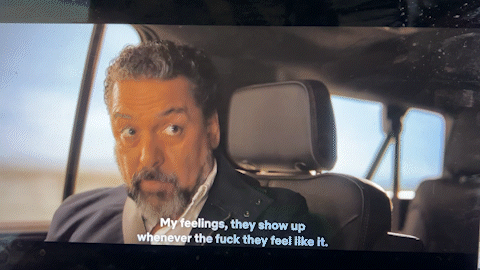
So I asked myself later what that was all about. What came up with in about 36 hours (instead of 3 years like the belief cycles I was locked in), was:
“Can’t you see me?” and
“Can’t you see I’m trying to do the right thing?”
And it is this abandonment-centred belief, accompanied by the life-saving dose of energy, that caused the irrational outburst, a trigger and projection related to my healing journey that, well, I needed, and an impatient driver behind me served as the punching bag for my training.
It is this journey that we have to take to understand how belief is the bedrock to emotion, which is the nursery of our thoughts. Our thoughts only after that, painting on the narration of us in our experience, and thus as close to how we would describe our identity as it gets.
It is not until we get to the belief and ask ourselves not ‘What do I need to do?’ but ‘Who would I like to be?’ and ‘What would it take to become that person’ - do we begin supplanting disempowering beliefs with empowering ones and have behaviour change consistently come about as a by-product rather than activities that feel icky.
I felt this difference clearly whilst sitting one time in a psychologists office. I pronounced that, “I am a recovering people pleaser” to which they replied, “Great, so you have finally found the words of refusal?” To which I, with age 4 anger-energy replied: “No, it was not the word ‘no’ I needed to learn. It was why I found it so difficult to say it that changed everything.”
Practising presenting boundaries or saying fond mantras about yourself may build the muscles in your mouth, but until it comes from somewhere inside of you that you have built a level of value around, it will always feel like you are doing it for someone else. Which was how we got here in the first place.
A Time of Cultural Poverty
This fragile elevation that marks our human making is being conducted in a time in which we have lost reverence for it whilst also having less capacity to do what evidently needs to be done.
Despite the black mirrors in our pockets, and fancy skyrises we may live and work in - we exist in a time of scarcity.
We think the winning of the 40-hour work week in 1947 in Australia260 was progress. But progress is relative. A 40-hour work week may be better than the year before, but what if I told you this was already the cultural norm a hundred years prior? Saint Monday was a near universally observed holiday in England up until the 1870s, removed only due to the threat of job loss as machines began competing against labour.261

And a hundred years before that people worked even less.262 Work was less structured; even at work, the productivity surrounding one’s attention to tasks varied by day, usually edging up as the week moved on, and cultural observances through religious holidays were more sacrosanct. The table below shows how ‘holy days’ reduced significantly alongside the removal of Saint Monday from 1750 to 1800.263
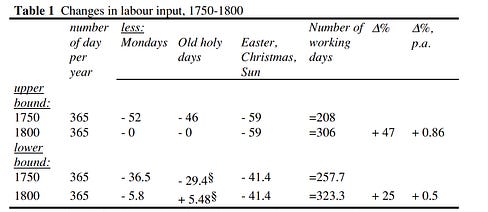
What life was like pre-domestication via the Agricultural Revolution and pre-machine-competition via the Industrial Revolution is still seen today in more traditional societies. Upwards of 40% of their day time is spent socialising, 20% is spent on personal tasks such as resting/napping, studying and eating, whilst the remaining roughly 40% is spent on subsistence, domestic activities and commerce.264 This matches with modern commentators speculating that our hunter-gatherer ancestors spent barely more than 2-4 hours per day working.265266
Upon arriving in Sydney in 1796, Matthew Flinders who led the first inshore circumnavigation of mainland Australia, noted at the Port Hacking River south of Sydney, that:
“...the sharks were so numerous that no other fish dare make its appearance. These sea monsters appeared to have a great inclination for us; and were sufficiently daring to come to the surface of the water, eyeing us at the same time with voracious keeness.”267
Whilst this prevented his afternoon fishing due to the small size of his vessel, the healthy stock of smaller fish, keeping the apex predator in such large surface numbers, was enjoyed well by the indigenous population who traded with these shocked sailors. Today, it is a special event for a shark to be spotted in the same location.
Instead of an overflowing natural bounty, agriculture made us reliant on weather patterns, defensive of the land we grew crops on and educated us on the nutritional value loss of constantly cultivated soil. The last part continues to alarm scientists today.268
Whether wild-caught or cultivated, we have changed the dynamics of our delicate ecological balance substantially in the last 12,000 years. Growing from 4 million people269 to more than 8 billion people today.270
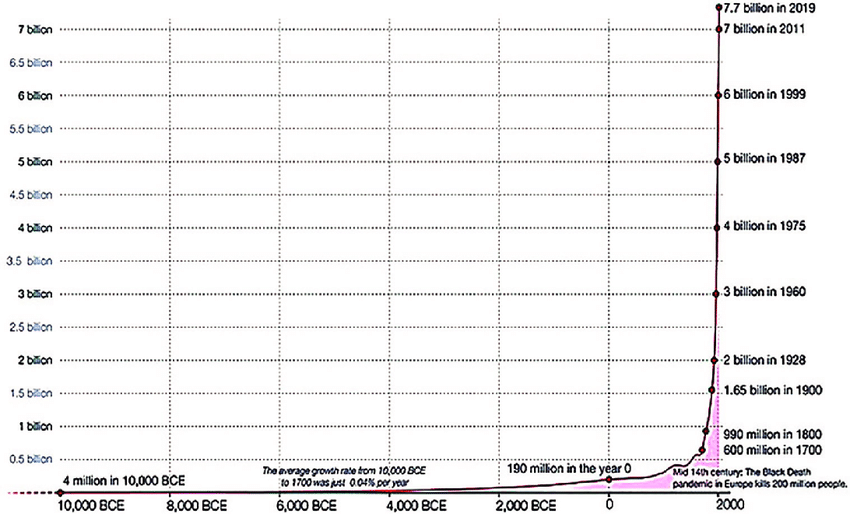
Just on a protein basis, wildlife populations have reduced by 70% in the last 50 years alone271 and domesticated cattle have risen only nominally from 1 billion to 1.5 billion,272 whilst over the same period, our population has increased by more than 5 billion. Engineered food has made up a lot of the gap.
Outside of food, it takes space to house that exponential chart and the competition for that naturally results in cost pressures. For example, it now takes 3 times as long to save for a home deposit in Australia than it did in 1980.273
In order to gain an average income to even meet the above statistic, we are now also required to upskill substantially more. This education creep is evident in my own family, with both of my parents leaving school and entering the workforce at 16 years old. It took me 5 more years of study before I graduated university at 21. Post-graduate studies are now increasingly in demand today. This education creep is a form of inflation as we trade what were previously child-rearing years for the ability to sustain middle-class aspirations.
When I did enter the workforce, it was one of contractualisation. Instead of the culture of my father’s time, who worked at the same company for over 20 years, my sister and I were on yearly contracts that were subject to quarterly performance reviews. In between that, I had a productivity tool to be updated hourly, letting upper management in on every file I touched and client I conversed with. This was followed up by in-person spot checks. Despite signing the hard-won 38-hour contract, 60-hour weeks were closer to my lower threshold (let alone any imaginary safety limit) and no extra reward for the effort. With job insecurity mediating the emotional contagion of exhaustion,274 I now see more of the humanity in my own burnout in my 20s.
This may sound like a societal gripe session, and to an extent it is, but more so, it is a compassionate inquiry into how our slowly evolving physiology is being called to meet quickly presented irrational demands that rationally lead us to disorganised states, even outside of traumatic events such as persecution, war or famine.
If you were monitoring the behaviour of another species in order to gain an idea of their social, cultural and resource richness, would you describe the trade-offs below as scarcity or abundance leaning?
- We accept inorganic food as the baseline and organic as a luxury. Despite inorganic foods association with inflammation,275 the destruction of the protective layer around our nerves (the same one we talked about with vitamin B12)276 and competition with glycine277 which when depleted, increases the desire for and effect of cocaine.278
- We accept contractual employment, with untimed full time jobs a luxury. Despite a euphemistic tagline of flexibility, it is felt as insecurity and far-reaching implications beyond just the threat of job loss.279280
- We accept ever greater debt in order to gain the opportunity to own our home281 with home ownership without a mortgage considered a luxury. And fewer of us are able to do so, once again, taking insecurity in the form of renting282 with its accompanying mental health implications.283284
These are security trade-offs that indirectly impact our capacity for human making, but we also make more direct compromises with our family.
This is poignantly seen in the rise of dual-income households.285 Another call-sign of inflation to meet our basic needs. One study showed it results in a gap in parent-child interaction of between 15-30 hours per week, not taking into account the exhaustion of that extra work in the capacity to show up in our spare time.
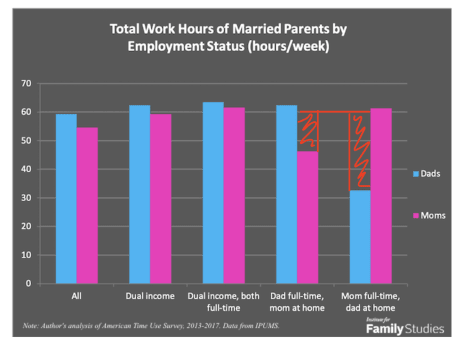
Whilst at work, children are exported to non-kin child care, which has been shown to increase cortisol,286 especially notable in children under 36 months.287 Unlike swapping organic for inorganic, full-time for contract and home ownership for renting - the caregiver trade-off is better described as all-or-nothing, as mum and dad are swapped for strangers.
This is the opposite of what we would do in the wild. Adult primates in times of scarcity put their peer-to-peer activities on hold in order to keep constant maternal-offspring engagements, and the safety it implies.288
Acceptance is a major part of overcoming, and it is unlikely these trends will reverse in our lifetimes, but to deny their coming about, once again assumes physiological responses are a shortfall of character instead of rational, and so we pretend they don’t exist. When we pretend they don’t exist, we never take an audit into the true circumstances in which we live, the true communication being offered by our bodies and those we care for (empathy), and therefore choose to live instead in ignorance.
Gaining a greater understanding of how feelings of abandonment can arise brings with it the logical responsibility to alleviate those feelings, which has been shown in the child-care buffering effects of secure maternal attachment289 and the highly time-effective (and western-dominated)290 paternal rough-and-tumble play.291
In this time of cultural poverty, with many adults having un-walked their own rite of passage, we see immature caregiving raising immature humans through many of the paths we have already uncovered with long-lasting impacts of persistent (and contagious) disorganised states. Committing to healing ourselves and raising others in our tribe has to be re-evaluated as the most important task we have in this lifetime.
A Sacred Journey
We have decision at this point, in light of these circumstances, in light of this awareness, what will I do?
Will I allow others to hold my sovereignty? or will I reclaim what is rightfully mine?
Will I decide to continue to live in ignorance? or will I heed the calling to my maturity?
Because that is the only way to our healing. A commitment to the return of our sovereignty, and the rite of passage of our maturity.
That healing is the only way we can prevent the next generation from compounding the ill-development of prior generations.
The best place to start, in my opinion, is to counterweight our disempowering beliefs of not deserving by ring-fencing the sanctity of this rare opportunity at life. To defend ‘us’ can feel strange, wrong, a struggle - but to tend to self-care of the finite attention credits you have in this time you will be here, a number we don’t even know the total sum of, means we are less open to spending them unwisely by being a plaything to the external winds of all other’s disturbance.
From a ground-up approach of reverence of life, we see that our responsibility lies less in a job or a chore, it is a noticing. It is not a learning, it is a remembering. It is not an accumulation; it is a removal of hindrances. For me, the most effective way to do that is through anchoring our experience in down-regulation.
It is said that coming to consciousness, healing, or saving ourselves usually comes in three ways:292
- A great suffering
- A great love
- Deep meditation
A great suffering may have brought us here, and a great love for life may keep us here, but it is a deep internal exploration that will paint the portrait of your experience.
We say to ourselves, perhaps my first attempt at human-making was insufficient, but it was only that, a first attempt and now I embark upon my second attempt: the journey from ignorance to awakening. Remember, people who have not felt the depths of the world do not have an impulse to unravel it - I will not curse my suffering; I will use it as the path forward.
Stephen Jenkinson shares his thoughts on this sacred journey:
“Human beings aren’t born,
human beings are made.
And how do you make humans?
Well, the answer is, you have to kill off their childhood.
Because why?
Because the childhood doesn’t give way, that’s why.
And then you need a culture that proceeds,
as if the greatest gift that you can give to kids at a certain age,
is to give them the chance to be human.”293
Killing the Childhood
The difference between meeting emotional experience with anxiety or empathy, as I posed the question originally, can be now considered the difference between childhood and adulthood. This is why we say it is a rite of passage.
Unhealed humans long to be complete, and their lost sovereignty in trying to find what they need keeps them in egocentric, childlike ways. Compassionately, we can understand this as the body once again trying to make us whole by raising our experience above others and seeking other’s support to alleviate concerns. We are judged on our track record as incompetent at demonstrating consistent empowering outcomes and thus are yet ready to pass on the book of human-making.
The fascinating part is we don’t have to depart from our scientific shoreline in order to recognise this rite of passage; it is clear to see in the brain, and it reminds us that age does not assure us wisdom. This is seen in the supramarginal gyrus and the dorsal prefrontal cortex, as touched on earlier:
“We showed that children display a stronger EEB than adults and that this correlates with reduced activation in right supramarginal gyrus (rSMG) as well as reduced coupling between rSMG and left dorsolateral prefrontal cortex (lDLPFC) in children compared with adults.”294
Re-emphasising, this same pathway is what separates ego-centricity in the adult population also.
This pathway even convienantly parallels our caregiver human making.
The emotional regulation from mum is represented in the more emotionally aligned rSMG, which is believed to be involved in overcoming egocentric biases in the face of emotional experiences.295
The confident separation from dad is represented in the executive function aligned lDLPFC, strongly associated with pro-social behavioural inhibition, its impairment giving way to impulsivity and reduced risk management.296
Rite of Passage Through Coming Home to Ourselves
The rite of passage is not to phone mum and dad though, as I have hinted at along this journey, it is to come home to ourselves. We have the ingredients inside us now to become the agent of our own rescue.
Yoga practitioners show heightened activation of the rSMG.297298
Compassion-based meditation, unsurprisingly perhaps, also activates this area, but so do focused attention and mantra-based practices.299300301 With increasing mindfulness scores associated with the activity relating to increasing connectivity.302
Not to be left out, breathwork and oxygen levels have been implicated in SMG activation.303304
In regards to the second component, the left dorsolateral prefrontal cortex (lDLPFC), appears to be a healthy by-product of learning to come home to our bodies in relation to its ability to help us meet stress-related circumstances.305 This is seen in meditators showing greater inhibitory (versus excitatory) neural responses in the lDLPFC,306 and those practising yoga gaining more efficient neural processing.307308
Once we have repaired the disorganised pathways that we have exhaustively uncovered through utilising the somatic tools that provide copious evidence of being able to meet those shortfalls, what we are looking to be left with is a sturdy container. The castle walls. That container is our bodily vessel and it stands in contrast to its prior condition of chronic porousness.
Putting Down the Bags
In this renewed ability to hold ourselves, the logical next step comes to put down some of the bags that we have picked up along the way. This can be scary on the first presentation. Knowing how heavy they have been in the past, we must prevent ourselves from projecting one data point into the future indefinitely.
Oftentimes, we think we can pretend something hasn’t happened, I’ve tried that for decades, but the body knows, and our day is not ours (lost sovereignty) because of it. Until we face what was previously too much, we will have great difficulties calling ourselves sovereign over our experience, and our body is here to help us through it too.
Sitting in our emotions and working through them somatically releases the most delta power within the brain compared to 8 other mindfulness practices.309
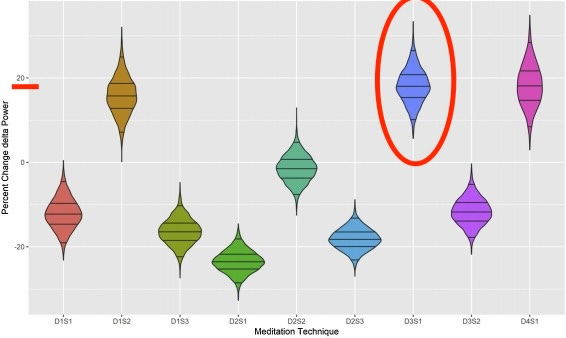
Not only does this delta power aid in glymphatic clearance310, which we earlier found was implicated in anxiety and depression, but it also helps our fear extinction pathways.311
What putting the bags down does, in feeling what is meant to be felt, and still be ok, is reduce the charge around our memories. In doing this, especially physically, we start to make boring what previously tormented our days. This is illustrated conveniently in the graphic below showing the same process of ordinary memory consolidation during sleep.312
Beyond the science, the sense of power that I have received from somatic re-integration experiences has been life-changing as I have shared in previous posts:
I will write more about these events in future posts, but I share my success as a means to contribute to the evidence that it is possible to move through that which otherwise seemed unbearable, under the right conditions. A possibility I struggled to find through talk therapy.
Your Hero Story
As we titrate our experience of overcoming and slowly reduce the charge around the big ticket items that sit in the back catalogue, we can start to open the door to telling a different story. Not of social defeat, disempowerment, and undeserving - but our hero story.
Regaining your sovereignty over your hero story calls for two actions:
- For you to recall where you came from
- For you to recall what you came here for
These are both intimately intertwined.
We need to take a sense of curiosity in exploring ourselves to the exclusion of our bodily senses that previously may have held us hostage. To do so we can start by asking, who am I when I am not coping?
This can be as foreign as a stranger when we first take this step, and the reason for this is once again well founded in the body trying to save us. As a child, our connection is non-negotiable. We can not raise ourselves. In times of scarcity and threat to attachment, we, therefore, sacrifice our authenticity, sometimes to the point of unfamiliarity, as we see ourselves only in reference and proximity to others.313314
The revealing of our authenticity may sound strange, a backward step in our maturity, as we focus on the ‘me’ when we were previously targeting an empathetic bias, but what we tend to find on the other side of anxiety, in empathy, is the idea of a life that is not defined by pushing, pulling and adding. It is about letting go, and that includes the ‘ego’ version of us, which is interchangeable with our hypervigilant bodily senses.
As we remove the hindrances to permit the blossoming of you, we can start to ask, what if your highest expression of yourself was love? In this scenario, that empathetic grounding is not a mutually exclusive arrangement of us versus them; it is radical self-care whilst maintaining increasingly strong but defined social support, sustained from a common source.
The way I like to describe this is that love is the roots that connect us all, it is the highest state of consciousness, and from that grounding belief, it is not our individual branches, leaves and flowers trying to build bridges to other branches, leaves and flowers via validation and superficial symbols of connection. It is the understanding that we are already connected, fundamentally and unconditionally, and it is our duty to respect our (and other’s) authentic expression.
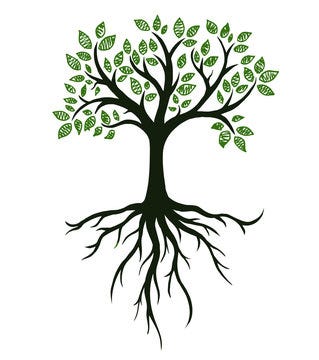
Psychotherapist Esther Perel talks to this in her observations315 of successful long-term romantic relationships. A major part of maintaining the fire of desire, is in not picking the flower,316 for your possession kills what you first found beautiful.
We are most attracted to our partners when we see them radiant (self-sustaining), creative and passionate. And especially when other tribe members are also drawn to those circumstances. We are forced to see our significant other in another light, which helps us wonder, appreciate and celebrate both partners’s uniqueness through intimate union.
Perel adds that people don’t talk about feeling a sense of desire when they are blended 5cm away from each other. Neediness for caretaking being a mighty anti-aphrodisiac. We know this also in platonic relationships. One person walks into a room and they reek of necessity, our body already feels lower in capacity knowing the petting they will require and the space feels physically constricted. Another person walks into a room, and our eyes open wide, a sense of possibility and abundance seemingly expanding the space for spontaneity, not a shopping list of emotional soothing.
So what marks that difference? And can we see ourselves occupying either one of the roles at various times in our lives? Which one would we like to spend more time in?
By anchoring our healing journey in down-regulation, we set up the opportunity to establish both the safe footing and surety of self that Mr and Mrs Abundance are born from. Our hyper-vigilance clouds and misaligns the true nature of things. Our body is uncertain about its ability to sustain homeostasis under the current circumstances, and so it drags our soul down, asking for answers or, at the very least, closure. In short, coping. When this carries on for long enough, we just call it life - despite having felt times or the presence of others where that was proven untrue.
Plotinus described this as souls forgetting who their father was317, and in doing so they start to believe they belong to themselves. Returning to my tree description, we find the leaves caught in the storm, or branches bending to touch another branch to prove it is not suspended in nothingness as it has lost feeling to its roots.
In forgetting where we came from, a great gap opens up that we try to fill with external pursuits and in chasing these things we only further dishonour ourselves, as Plotinus continues:
“...for to pursue and marvel at something is at the same time to accept that one is inferior to that which one is pursuing and to that at which one is marvelling.” 318
This is why I always felt empty even after the people pleasing and appearances by association. It was not durable or lasting because it was not me I was even asking to be validated, and I had not taken the time to figure out who that ‘me’ was yet.
As squashed spiritual orphans, we adhere to the temporary satiation of our senses. By reconnecting to ourselves via down-regulation, we restore the original balance. We close the gap between our disorganised state and the peace that sits in the background waiting for us always; the distance between that and our current state is naturally equal to our suffering.
As we do this, we see the two unanswered questions create a circle. Where I came from, and what I came here for - end in the same place. As we down-regulate the nervous system and subordinate the bodily senses (ego) to the purposes of our soul, we move towards our highest expression of love which is also the roots we were born from, and marks our competence in meeting the non-negotiable final chapter of our journey home.
The Cost of Not Taking the Sacred Rite of Passage
As we have seen, the ill development of pre-programmed neural pathways keeps us stunted in childlike forms and delivers ego-driven outcomes. Compassionately, we completely understand why, the body is still trying to save us.
A strong ego is evolutionarily a necessity for post-natal development, the human form being one of the weakest to emerge from its mother’s womb into the world. It demands human-making from the elders who came before, in order to set up a durable bodily vessel for the borrowed time our soul occupies it.
The trouble is, many of us, including myself, have found, despite being of an age that would represent someone who has taken the rite of passage into the other side of the equation as an elder and continued unearthing their uniqueness - were still stuck in immature states. These immature states are dominated by hyper-vigilance as our context, our unfinished care and potentially consequential life encounters, continue to stick to our experience. This forms a cage of shame that confuses us into believing our past is both our fate and an accurate narration of our identity.
Embarking upon this sacred journey ensures that not only do we heal ourselves, but we offer up a cultural bounty to those coming after us instead of asking the next generation to pick up where those before us were found wanting. An evolutionary push for making ourselves whole, asked again and again until someone answers the call.
Maternal intergenerational transmission
We have suggested some of the faulty scripts of intergenerational trauma and cultural poverty already, but specifically in regards to the disorganised states of a mother, we have ample more examples.
Depressed mothers produce girls (but not boys) who have a larger right amygdala by the age of 4.5319 that has been implicated, as previously described with PTSD,320321 anxiety,322323324325 depression,326327328 autism,329 and future less sensitive maternal caregiving.330
Six-month-old infants of mothers with depression show amygdala structures similar to that of adolescents and adults already diagnosed with depression,331 once again highlighting the transferability of these ‘bags’ we carry in quick succession.332333 Seen further in the offspring of depressed mothers having language development shortcomings334 and poorer emotional regulation.335
Even emotional imbalance, not necessarily a diagnosed condition, is contagious. Children of mothers who self-silence, show self-silencing by the time they reach preschool.336337 Children of mothers who show hostility show less effortful control of their emotions.338
Paternal Intergenerational Transmission
A mother’s evolutionarily supported role as an emotional regulator is an obvious and well-researched area contributing to disorganised states. However, a father is certainly not immune to downstream implications also.
When a man has a child, an interesting phenomenon takes place. His testosterone drops, so does his cortisol, while oxytocin levels increase.339
What is increasingly interesting is that the level of testosterone drop he experiences is associated with his investment in his child.340341 So much so that his testosterone drop on the 2nd day of his infant’s life will predict his level of care months later.342
However, this predictor can be bet on, even before he is a man himself.
Boys whose fathers lived with and were involved in caregiving during their adolescence had lower testosterone when it was their time to be a father.343344 Demonstrating a multi-generational impact of a father gap.
So what happens when he provides a lower level of care, or what is the gap of care that a father is biologically programmed to provide?
When I say confident separation, it is due to the father’s role in seeing the child successfully on-ramp to a wider social life outside of the family home. It is his acceptance of his child (or rejection) that has been shown to mediate childhood anxiety levels, not the mother’s.345 It is his attachment with his child that is the biggest predictor of a child’s ability to transition into pre-school, not the mothers.346
Modern times are certainly different now than when we were living in tribal structures, but this smooth, anxious-free social transition is a call back to a time when children were socially ranked through their fathers. Today a remnant of this is still seen in the keeping of the groom’s last name upon marriage. Genealogies not too long ago referred to the bride as the daughter of her father.
I can trace my family tree back on my mother’s side to the Earls of Orkney and Shetland, and the Orkneyinga Saga provides a pedigree chart with descriptions such as “Ragnhild daughter of Eirik Bloodyaxe” or even less specifically, the order of marriage such as wife number “...(2) daughter of Malcolm King of Scots.”347 Which we find absurd today, but provided at that time a very big clue as to the social relevance of the family. This social rank serves as a marker for access to resources and thus acts as a proxy also for protection.
In times earlier than this, no doubt a father’s role as the physical protector of his family was dominant, and we still see this in primates.
Even in promiscuous mating species, where paternal investment is thought to not be worth the risk of caring for a non-related child, fathers have perplexed scientists by correctly identifying his children, and we still don’t know how. The way he demonstrates that is by intervening on behalf of his offspring, showing repeated support during agonistic conflicts and harassment.348349
Paternal investment through time spent in proximity has also been shown to be associated with the male dominance rank, which tended to lead to richer food resources for the young. There is no clear evidence these highly ranked males benefited at all from these caregiving relationships.350
Anthropologically, once again we see a clearer picture behind feelings of abandonment.
Examples of mother primates maintaining time with their child in the face of food scarcity, and father primates protecting their children and even more so from a highly ranked position associated with lower stress levels351 - suggest to our primitive nervous system: scarcity and insecurity. It may be us that has to be sacrificed in these uncertain times, based on the only observational cues available.
Fast forwarding our evolution back to humans, we see that a father’s poorer regulation of anger (corresponding to his defensive role) leads to poorer attachment with his children and their subsequent higher childhood anxiety scores.352
As a final example of the highly influential role of the father in raising and socially empowering his children, the odds of attempted suicide are more than two times higher for adolescents insecurely attached to their father as compared to their mother.353
The babbling father often portrayed on TV sitcoms is a far cry from the hundreds of thousands of years, potentially millions of years, of the strength of paternal care, being an indicator of confident caregiving and cultural abundance.
Physiological decay
I’ve met several people along my way who have answered my intergenerational flag-waving with the easy solution of not having kids. And each person is within their right to choose that path. Therefore I present another motivation (caution) for when we do not take the sacred journey.
That example is the deterioration of you. Until I found breakdown, once, twice and finally three times, I believed I was near invincible. My desires were only elbow grease away, as long as I tried hard enough, the world would eventually be kind. This false karmic debt stands in contrast to the confines of our bodily vessels. Yes, we can place our attention on the priorities of our lives, and we can tend to those priorities. But if we do so via decades of hyper-vigilance, we will reach adrenal insufficiency, just as I have described earlier.
But the body doesn’t give up on us that easily, we dig into the reserves. One such example of this is the bones. When we are incapable of mounting a stress response, which, if you are living in persistent hypervigilance, may well be from the moment you hop out of bed, the bones give us the power to do so. Instead of dedicating their energy to the process of bone renewal, they double the release of osteocalcin (a protein), to activate what it considers a life-saving bout of energy. This has led scientists to label, as of 2019, the bones as a stress organ, and osteocalcin as a stress hormone.354
It is no wonder bone density is related to depression355 and that the exhaustion of osteocalcin is related to anxiety, reductions in neuroplasticity356 and intergenerational development issues in fetal brain development.357
Giving ourselves the permission to stop, build the castle walls, and ask a few questions about who we would like to be and what it takes to get there, is some of the strongest self-care available to us.
Waterfall Effect
A further admission we must make with ourselves, if we do not choose to take the rite of passage of our maturity, is the loss of daily sovereignty of our experience. Our very conscious interpretation of what is happening right here, right now.
A term I have given the unconscious (stuck in ignorance?) phenomenon in which the body tries to save us by relieving pressure, is the Waterfall Effect. This is because the release valve is most commonly found in less socially dominant relationships.
As a simple example, this can be seen in mothers who project their insecure relationship with their partner or father, onto their son. They ask him prematurely to be their social validator and protector.
This creates men who have the knight in shining armour complex for every damsel in distress. This can sound like a fairytale, but it is both exhausting and disempowers his future partner’s right to agency. It tends to attract him to relationships where his source of continual confirmation of connection is found via ‘fixing’ rather than being. A perpetuation of childhood ill-development and contract to conditional love.
Another example can be seen in fathers who have an insecure relationship with their mother, and find difficulty in emotional regulation. They vent their social boundary through anger that was intended for a boss, colleague or client, onto their son or daughter. He asks for lower demands on his hyper-aroused nervous system, due to never putting in the reps of self-down-regulation. Anger is born from his loss of control, and in trying to find safety, he rejects his child.
This creates children who feel like they are burdens and may fall into self-sabotage behaviour such as perfectionism as they can’t rely on a plan B in the event of failure or, falling for false father figures calling for the validation they sought in their adolescence. Cheap praise will go far, and create sub-par roadmaps for romantic relationships for his daughter and likely risk-taking by his son.
As you are building your map of human-making, no doubt you can piece together any number of other combinations of untaken rite-of-passage consequences that compress our reality to coping. It may not be a child, it may be a submissive friend or relative, whoever becomes that emotional punching bag though is only a source of continuing the maladaption the body is calling attention to.
Cycles of Regressive Longing
We have the next generation to think of, we have our bodily vessel to think of, and we have a reality beyond the conscious projections of coping - the last piece to add is that of overcoming a regressive longing.
When we are stuck as children, literally in the wiring of our brain, a disorganised state that gives rise to dysfunctional outcomes, our body yearns, especially after extended periods, for the care and connection of a time long passed.
The warm fuzzy feeling that comes about in this refuge is through oxytocin and its varied maternal and paternal contractual implications.
Oxytocin is often spoken of as a bonding hormone, but another way I like to look at it is as a connect and protect hormone. It is not just a lovey-dovey by-product of affection; it is an agreement between an in-group, and upon signing this, the nervous system swims in an analgesic bliss.
Oxytocin remarkably suppresses the amygdala358359360 whilst also increasing the ability to be aware of social and emotional signals.
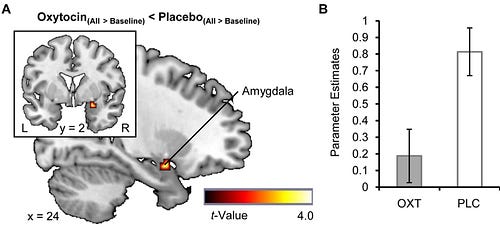
The absence of cortisol release is due to the recognition of increased access to resources of others in order to meet a stimuli/threat.361362363 Very simply, we see more threats but feel they are shared responsibility, so on average, we feel less stressed.364
In a regressive state, we are driven by a desire for a mother’s smothering and a father’s defence. Breaking free of this is paramount to our ability to reclaim our emotional sovereignty, but understanding the deep obligations oxytocin contains helps us understand why this inertia can exist in ill-developed states.
Paternal Longing
Oxytocin in a man produces a response that might be surprising to hear given the valentines day-esque social coating we have for the hormone. It makes him actually increase negative social judgments of others.365
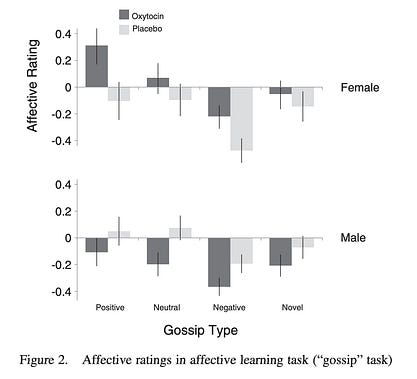
It promotes the identification of competitors.366
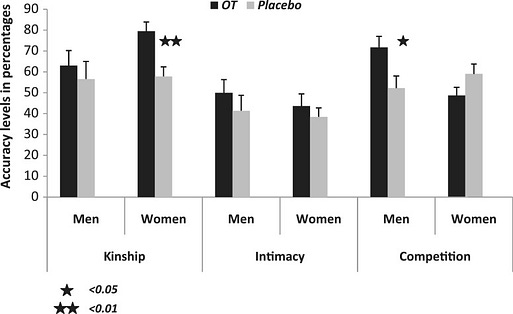
It also makes him see others as generally less likeable.367
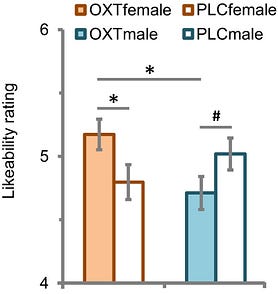
But this is not an anti-social hormone. It is a family-first approach to securing his genetic legacy and he is fulfilling his protector role. This is seen in reducing his likelihood of being attracted to other mates by making him stand at a further distance from unfamiliar females, but only if he is in a monogamous relationship.368
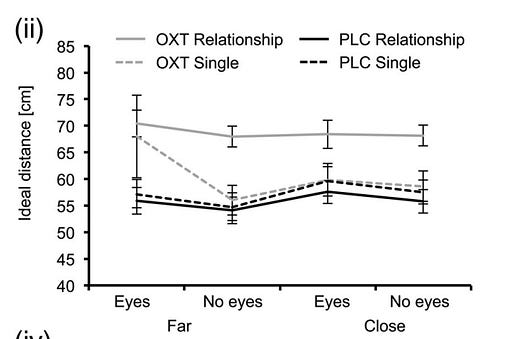
This feeling of having a guardian over us that we can trust, will see the threats we can not see, and defend against those threats we have not been able to defend against, is a natural response to pro-longed disorganised states. Just as with the Waterfall Effect, this yearning can be projected onto many social others who are not our fathers, but in this case, making us attracted to more socially dominant relationships. In environments absent a mature social network and/or kin this is a volatile recipe for exploitation.
Maternal Longing
Opposite to her male partner, a female high on oxytocin, is enthusiastically prosocial. It increases her positive social judgments of others,369 it makes her less aggressive in couple conflicts, 370 it lowers her ability to identify competitors,371 and more generally she sees other people as more likeable.372
The picture being biologically painted here in the village is one of the aunties coming together to assist in the high-demand context of caregiving for another human. Prior rivalries have the steam taken out of them as the solitary goal of looking after the next generation smooths over any rough edges.
Before we end there though, it must be noted that even if mum relies on dad for defence, she is still the last line before the child should he fall.
This is seen, almost unbelievably in the story of a mother fighting off a 320kg polar bear to save her son,373374 and complements the often told tale of a mother’s strength to lift a car of her child. As it turns out, this has happened on several occasions and has been put down to the phrase ‘Hysterical Strength.’375376
This maternal defence is still meditated by oxytocin377378 where oxytocin knock-out / suppressed animals refuse to show aggression to intruders379380381 in order to protect their young.
It is this warmth, with a back-up card of ‘Hysterical Strength’ that draws us towards mother figures in our lives. A school teacher, an elder sister, or even a partner. Just as with the paternal longing, though, we are asking for a hat to be worn that occupies space otherwise reserved for that person’s role and authentic expression. If we ask our partners to be our mothers, therapists, best friends, business consultants - we can’t be surprised to find periods in which the lover spark has blown out. It’s too many hats and is a product of our unmet needs, rather than a celebration of both a unique expression and a union between two unique expressions.
The Teacher We Didn’t Ask For
By committing to reclaiming our emotional sovereignty, we learn to listen to the body, rescue what has experienced ill development and then sub-ordinate the body to its natural state below our sense of self/soul/spirit/authentic you.
It is a very human struggle of human making, and it does not happen by chance or fate. The absent RSVP on our invitation to life is a sign of disrespect to all those who came before us and deprives all those who came after us as we become the kink in the human hose.
Returning a reverence to this life is the first step of re-writing our relationship with ourselves. Seeing the rareness of the opportunity, we start to value what we have been gifted and we tend to protect and take care of what we value. This is the attitude from which we can begin our journey of self-care back to functionality.
Adult anxiety, depression, dissociation, PTSD or any other disorganised state, is just that: a state. We have the tools to bring us back, and not only that, we can use it as a platform to experience this life to a depth we may not have previously found possible.
This may well be our suffering today, but it doesn’t need to be forever. Perhaps one day we will see this suffering as the Teacher we didn’t ask for, but the Teacher we needed.
To your healing 💙,
Jas
jason@jasfield.com - 1-to-1 guidance waitlist
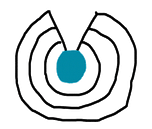
1https://www.nature.com/articles/s41598-020-65582-0?fromPaywallRec=false
2https://www.sciencedirect.com/science/article/abs/pii/S2352250X17301288?via%3Dihub
3https://pmc.ncbi.nlm.nih.gov/articles/PMC6438321/
4https://youtu.be/hvbQ9sr2Ols?si=bRhcrtdiH9vBOTgk&t=168
5https://srcd.onlinelibrary.wiley.com/doi/10.1111/cdep.12347
6https://www.sciencedirect.com/science/article/pii/S0306453018300246#fig0005
7https://fuerkinder.org/wp-content/uploads/2023/03/Mother-Infanft-Brain-to-Brain-Synchrony.pdf
8https://www.pnas.org/doi/full/10.1073/pnas.1702493114
9https://pubmed.ncbi.nlm.nih.gov/24439036/
10https://pubmed.ncbi.nlm.nih.gov/23408268/
11https://www.ncbi.nlm.nih.gov/pmc/articles/PMC7937662/
12https://pubmed.ncbi.nlm.nih.gov/29545749/
13https://link.springer.com/article/10.1007/s40429-017-0135-1
14https://www.ncbi.nlm.nih.gov/pmc/articles/PMC4821810
15https://www.sciencedirect.com/science/article/abs/pii/S002839081830443X
16https://www.google.co.id/books/edition/In_an_Unspoken_Voice/OdjwjyDbp0wC?hl=en&gbpv=1&dq=%E2%80%9CTrauma+is+not+what+happens+to+us,+but+what+we+hold+inside+in+the+absence+of+an+empathetic+witness.%E2%80%9D&pg=PR12&printsec=frontcover
17https://psychiatryonline.org/doi/10.1176/appi.ajp.2007.07030504
18https://www.sciencedirect.com/science/article/pii/S2950588724000326
19https://www.frontiersin.org/journals/neuroscience/articles/10.3389/fnins.2021.643597/full
20https://www.google.de/books/edition/Lost_Connections/L0MIEAAAQBAJ
21https://www.sciencedirect.com/science/article/pii/S2352289523000747#fig4
22https://www.researchgate.net/profile/Godehard-Weniger/publication/6013483_Size_abnormalities_of_the_superior_parietal_cortices_are_related_to_dissociation_in_borderline_personality_disorder/links/5c04e60da6fdcc1b8d50b413/Size-abnormalities-of-the-superior-parietal-cortices-are-related-to-dissociation-in-borderline-personality-disorder.pdf
23https://pmc.ncbi.nlm.nih.gov/articles/PMC9502311/
24https://onlinelibrary.wiley.com/doi/abs/10.1002/1099-1611%28200005/06%299%3A3%3C259%3A%3AAID-PON448%3E3.0.CO%3B2-Y
25https://pmc.ncbi.nlm.nih.gov/articles/PMC10623013/
26https://pmc.ncbi.nlm.nih.gov/articles/PMC6289073/
27https://www.sciencedirect.com/science/article/abs/pii/S016503270800089X
28https://archive.org/details/PlatosPhaedo1954/page/n33/mode/2up?q=learning
29https://archive.org/details/PlatosPhaedo1954/page/n85/mode/2up?q=learning
30https://ftp.budaedu.org/ebooks/pdf/EN456.pdf
31https://archive.org/details/mahs-cgjmlvf_images/page/110/mode/2up
32https://pmc.ncbi.nlm.nih.gov/articles/PMC4321629/
33https://www.jneurosci.org/content/jneuro/33/39/15466.full.pdf
34https://pmc.ncbi.nlm.nih.gov/articles/PMC7005764/
35https://scholars.huji.ac.il/sites/default/files/atzillab/files/atzil_et_al._2012.pdf
36https://www.researchgate.net/publication/26890851_Brain-based_sex_differences_in_parenting_propagate_emotion_expression
37https://scholars.huji.ac.il/sites/default/files/atzillab/files/atzil_et_al._2012.pdf
38https://pmc.ncbi.nlm.nih.gov/articles/PMC10299859/
39https://www.tandfonline.com/doi/full/10.1080/14616734.2019.1589058#d1e163
40https://ruthfeldmanlab.com/wp-content/uploads/2019/06/Oxytocin-and-parenting.BiolPsych.2010.pdf
41https://ruthfeldmanlab.com/wp-content/uploads/2019/06/natural-variations.PNEC2010.pdf
42https://www.cambridge.org/core/journals/behavioral-and-brain-sciences/article/abs/brainbased-sex-differences-in-parenting-propagate-emotion-expression/8EF82E49A9EDC32E99E47FCB4405F22D
43https://www.cambridge.org/core/journals/behavioral-and-brain-sciences/article/abs/brainbased-sex-differences-in-parenting-propagate-emotion-expression/8EF82E49A9EDC32E99E47FCB4405F22D
44https://www.researchgate.net/profile/Michael-Lamb-8/publication/238328204_Father-Infant_and_Mother-Infant_Interaction_in_the_First_Year_of_Life/links/59db29b70f7e9b12b36fb99d/Father-Infant-and-Mother-Infant-Interaction-in-the-First-Year-of-Life.pdf
45https://onlinelibrary.wiley.com/doi/abs/10.1002/1097-0355(198124)2:4%3C241::AID-IMHJ2280020406%3E3.0.CO;2-8
46https://www.mdpi.com/2076-2615/10/10/1894
47https://www.sciencedirect.com/science/article/abs/pii/S0168159198002020
48https://www.semanticscholar.org/paper/Parent-specific-reciprocity-from-infancy-to-shapes-Feldman-Bamberger/7f29d442fd0234d0bf821c96b3bc11ef85f72202
49https://scholars.huji.ac.il/sites/default/files/atzillab/files/atzil_et_al._2012.pdf
50https://www.nature.com/articles/s41598-021-81454-7
51https://www.researchgate.net/publication/26890851_Brain-based_sex_differences_in_parenting_propagate_emotion_expression
52https://pubmed.ncbi.nlm.nih.gov/9923473/
53https://www.sciencedirect.com/science/article/abs/pii/S0165032723004895
54https://d1wqtxts1xzle7.cloudfront.net/65621190/Doll_NeuroImage2016-libre.pdf?1612625696=&response-content-disposition=inline%3B+filename%3DMindful_attention_to_breath_regulates_em.pdf&Expires=1735535615&Signature=FevXS31s-10XKHZToKuze4TwxLhOVtF~~aK4F2PGAOSYorUBdjlrattjKBsHob7KSVeg5LTPxeitnH2Qkm3J2-cQl9Sj63G3LsD7~3eBlnCARXOtFN8bILlTKWgad22O~4JVCL7fcFhpsGn~qyiU8biLmr1WgAgkBjlBUV3ujgfJHE1eH8U6UujryF47v4D1MeZyVdXSeSZZy4xIgV5OvbYFwiTqqroklwnBFR5fKyblKwPRcBtbuc63vEc-~GBJpOeDOFYrbbjcP9AuXFcdmD8o35KkncKYV9OWDO9NOfNjEnnC~UOpNnSRA2BrJf2rUwsz2r5gTlPFpfWBv5RA5w__&Key-Pair-Id=APKAJLOHF5GGSLRBV4ZA
55https://pmc.ncbi.nlm.nih.gov/articles/PMC10026337/#ref24
56https://journals.plos.org/plosone/article?id=10.1371/journal.pone.0147774
57https://pmc.ncbi.nlm.nih.gov/articles/PMC6289073/
58https://greatergood.berkeley.edu/images/uploads/The_Neural_Basis_of_Empathy.pdf
59https://web.archive.org/web/20200226111038id_/https://www.zora.uzh.ch/id/eprint/84206/1/Right_supramarginal_gyrus_Silani.pdf
60https://youtu.be/qi4VwpEs3LE?si=QZPEnzpPo32SDCt1&t=1028
61https://youtu.be/XT_6Lvkhxvo?si=hZKTDGzgqigucjjW&t=628
62https://youtu.be/kDBzJNU7Mb8?si=DxbZQxnxhFgPIpTw&t=695
63https://pmc.ncbi.nlm.nih.gov/articles/PMC4477228/
64https://melindawmoyer.substack.com/p/why-music-and-dance-foster-compassion
65https://www.ncbi.nlm.nih.gov/pmc/articles/PMC7937662/
66https://pmc.ncbi.nlm.nih.gov/articles/PMC7005764/
67https://pubmed.ncbi.nlm.nih.gov/25513669/
68https://ruthfeldmanlab.com/wp-content/uploads/2019/06/OT-and-cross-generation-transmission.HB2010.pdf
69https://pmc.ncbi.nlm.nih.gov/articles/PMC9953313/
70https://pubmed.ncbi.nlm.nih.gov/24439036/
71https://pubmed.ncbi.nlm.nih.gov/23408268/
72https://www.ncbi.nlm.nih.gov/pmc/articles/PMC7937662/
73https://www.sciencedirect.com/science/article/pii/S1878929312000436#fig0005
74https://www.sciencedirect.com/science/article/pii/S0022096521002423#:~:text=Both infant attention at 4,across the Netherlands and China.
75https://d-nb.info/1248406060/34
76https://www.google.de/books/edition/The_Development_of_the_Person/CPehiEmvbEgC
77https://link.springer.com/article/10.1186/s12887-022-03248-8?fromPaywallRec=false
78https://www.ncbi.nlm.nih.gov/pmc/articles/PMC5415433/#:~:text=Results suggested that more frequent,(ages 19–22).
79https://annamachin.com/dads-the-untapped-mental-health-taskforce/
80https://www.ncbi.nlm.nih.gov/pmc/articles/PMC5415433/
81https://ruthfeldmanlab.com/wp-content/uploads/2019/05/OT-pathway-genes.BPS_.2016.pdf
82https://www.tandfonline.com/doi/full/10.1080/09297049.2017.1338340#d1e373
83https://pmc.ncbi.nlm.nih.gov/articles/PMC3440552/
84https://www.researchgate.net/profile/L-Alan-Sroufe-2/publication/5390481_The_Construction_of_Experience_A_Longitudinal_Study_of_Representation_and_Behavior/links/5c327a83458515a4c712b2ed/The-Construction-of-Experience-A-Longitudinal-Study-of-Representation-and-Behavior.pdf
85https://www.cyriltarquinio.com/app/download/5817694781/Perry+et+al+attachement.pdf
86https://www.researchgate.net/publication/7607535_Altered_cortisol_awakening_response_in_Posttraumatic_Stress_Disorder
87https://pmc.ncbi.nlm.nih.gov/articles/PMC4300007/
88https://www.researchgate.net/figure/Hippocampal-volume-in-PTSD-on-a-coronal-MRI-The-hippocampus-is-visibly-smaller-in-the_fig2_308382757
89https://www.researchgate.net/figure/Reduced-gray-matter-volumes-of-the-bilateral-hippocampi-in-PTSD-patients-A-the-color_fig13_263742556
90https://www.sciencedirect.com/science/article/abs/pii/S0165032723004895
91https://pubmed.ncbi.nlm.nih.gov/25409592/#&gid=article-figures&pid=figure-1-uid-0
92https://pmc.ncbi.nlm.nih.gov/articles/PMC7219892/
93https://www.sciencedirect.com/science/article/abs/pii/S1053811915007600
94https://pmc.ncbi.nlm.nih.gov/articles/PMC7219892/
95https://pmc.ncbi.nlm.nih.gov/articles/PMC4236295/
96https://www.jmoodanxdisorders.org/article/S2950-0044(24)00019-1/fulltext
97https://onlinelibrary.wiley.com/doi/full/10.1002/hbm.70099
98https://www.psychiatry.wisc.edu/courses/Nitschke/seminar/sapolsky_arch_gen_psych_2000.pdf
99https://pmc.ncbi.nlm.nih.gov/articles/PMC4300007/
100https://www.psychiatry.org/psychiatrists/practice/dsm
101https://www.psychiatry.wisc.edu/courses/Nitschke/seminar/sapolsky_arch_gen_psych_2000.pdf
102https://pmc.ncbi.nlm.nih.gov/articles/PMC5943737/
103https://thehubedu-production.s3.amazonaws.com/uploads/4991/a09d3113-87f1-4b40-87e6-b81eee5c06bf/Psych_PTSD_Article.pdf
104https://europepmc.org/article/med/17073653
105https://www.researchgate.net/figure/Reduced-gray-matter-volumes-of-the-bilateral-hippocampi-in-PTSD-patients-A-the-color_fig13_263742556
106https://www.psychiatry.wisc.edu/courses/Nitschke/seminar/sapolsky_arch_gen_psych_2000.pdf
107https://www.researchgate.net/publication/38024005_Altered_Hippocampal_Morphology_in_Unmedicated_Patients_with_Major_Depressive_Illness
108https://pmc.ncbi.nlm.nih.gov/articles/PMC3233754/
109https://www.jmoodanxdisorders.org/article/S2950-0044(24)00019-1/fulltext
110https://www.cyriltarquinio.com/app/download/5817694781/Perry+et+al+attachement.pdf
111https://pubmed.ncbi.nlm.nih.gov/19595774/
112https://pmc.ncbi.nlm.nih.gov/articles/PMC2367228
113https://www.pnas.org/doi/full/10.1073/pnas.1907170116
114https://pubmed.ncbi.nlm.nih.gov/25997768/
115https://www.pnas.org/doi/full/10.1073/pnas.1601443113
116https://pmc.ncbi.nlm.nih.gov/articles/PMC4930120/
117https://www.sciencedirect.com/science/article/pii/S1053811920307114
118https://www.google.de/books/edition/The_Body_Keeps_the_Score/3Q3UAgAAQBAJ
119https://www.researchgate.net/figure/A-Brain-regions-associated-with-PTSD-across-symptom-provocation-and-cognitive-emotional_fig1_228080474
120https://www.nature.com/articles/s41398-020-00974-4
121https://www.nature.com/articles/s41398-022-01977-z
122https://d1wqtxts1xzle7.cloudfront.net/44214459/Amygdala_gray_matter_concentration_is_as20160330-21080-a3uci4-libre.pdf?1459382429=&response-content-disposition=inline%3B+filename%3DAmygdala_gray_matter_concentration_is_as.pdf&Expires=1734626755&Signature=SluZj-jSFVRPnd~LZO6ggkssEIjw-8qstjOeENgJUvlo197T7rF6-ShnbcisqI8gvaaXe0VAuo9GwC27jKwM5DfT6pT5vJDIQ0oxy7kkFG2FxNCdRFhICV9ILJRwafBxM2LjtMmzGlpJnX6scQLx1Z-sD6H3sCClvWGzIa3y5CdpJdTDhwLtNqb16WVs67quusvcVRt5drIYQ9D~p1OPE75T0AnTI9yVb12HsqOZIysrOlAZhtjPhqM9VxZTJS~soSVQEyxhs3ypZJF90NBnIU0h6i2pDAXVBR~stTvski8B0B2XNfYjVMO1Kni3AkbMhoPrxwIKnT30EnBH6J~gdA__&Key-Pair-Id=APKAJLOHF5GGSLRBV4ZA
123https://pmc.ncbi.nlm.nih.gov/articles/PMC3220767/
124https://www.sciencedirect.com/science/article/abs/pii/S0890856710002005
125https://www.umassmed.edu/globalassets/center-for-mental-health-services-research/documents/products-publications/presentations/wellness/neurosciencemindfulness.pdf
126https://kristyna.co/mindful-entrepreneurship/neuroscience-of-mindfulness-what-exactly-happens-to-your-brain-when-you-meditate
127https://pmc.ncbi.nlm.nih.gov/articles/PMC2840837/
128https://vydavatelstvo-f.sk/sites/default/files/atzil2011-pdf.pdf
129https://gmint.informatik.uni-freiburg.de/teaching/wt18_19/material/Sethna_2017.pdf
130https://acamh.onlinelibrary.wiley.com/doi/full/10.1111/jcpp.12317#
131https://www.nature.com/articles/s41380-022-01720-6
132https://www.sciencedirect.com/science/article/pii/S1382668923001746
133https://pmc.ncbi.nlm.nih.gov/articles/PMC3119362/
134https://pmc.ncbi.nlm.nih.gov/articles/PMC3947720/
135https://europepmc.org/article/med/37307604
136https://pmc.ncbi.nlm.nih.gov/articles/PMC11507665/
137https://www.sciencedirect.com/science/article/pii/S235228952300019X
138https://europepmc.org/article/med/28397390#hbm23600-bib-0030
139http://sa.indiaenvironmentportal.org.in/files/City%20living.pdf
140https://www.bu.edu/sph/news/articles/2018/the-future-is-urban-global-and-unequal/
141https://www.jstor.org/stable/1350924
142https://www.google.de/books/edition/The_Body_Keeps_the_Score/3Q3UAgAAQBAJ
143https://studenttheses.uu.nl/handle/20.500.12932/12173
144https://www.researchgate.net/figure/A-Brain-regions-associated-with-PTSD-across-symptom-provocation-and-cognitive-emotional_fig1_228080474
145https://www.google.co.id/books/edition/The_Body_Keeps_the_Score/FMPdAgAAQBAJ?
146https://rajeevraizada.github.io/papers/Raizada_SES_Brocas_NeuroImage2008.pdf
147https://www.aft.org/sites/default/files/media/2014/TheEarlyCatastrophe.pdf
148https://pmc.ncbi.nlm.nih.gov/articles/PMC7005764/
149https://pmc.ncbi.nlm.nih.gov/articles/PMC7927301/
150https://pmc.ncbi.nlm.nih.gov/articles/PMC2562652/
151https://pmc.ncbi.nlm.nih.gov/articles/PMC5945324/
152https://www.tandfonline.com/doi/full/10.1080/09669760.2022.2144147#abstract
153https://www.tandfonline.com/doi/abs/10.1080/10409289.2013.736036
154https://pubmed.ncbi.nlm.nih.gov/24817812/
155https://www.researchgate.net/profile/David-Bjorklund/publication/368794518_Decline_in_Independent_Activity_as_a_Cause_of_Decline_in_Children's_Mental_Wellbeing_Summary_of_the_Evidence/links/63ff5ef0574950594554052d/Decline-in-Independent-Activity-as-a-Cause-of-Decline-in-Childrens-Mental-Wellbeing-Summary-of-the-Evidence.pdf
156https://www.google.de/books/edition/The_Body_Keeps_the_Score/3Q3UAgAAQBAJ
157https://pmc.ncbi.nlm.nih.gov/articles/PMC7005764/
158https://kripalu.org/resources/how-yoga-helps-heal-trauma-qa-bessel-van-der-kolk
159https://pmc.ncbi.nlm.nih.gov/articles/PMC6971819/
160https://pmc.ncbi.nlm.nih.gov/articles/PMC6302143/
161https://www.jneurosci.org/content/35/28/10281?utm_source=TrendMD&utm_medium=cpc&utm_campaign=JNeurosci_TrendMD_0
162https://onlinelibrary.wiley.com/doi/abs/10.1002/ana.25178
163https://physoc.onlinelibrary.wiley.com/doi/10.1113/expphysiol.2008.042424#b41
164https://www.jstage.jst.go.jp/article/physiolsci/57/2/57_2_121/_pdf/-char/en
165https://www.jneurosci.org/content/36/49/12448?fbclid=IwAR3ntZcmw4q6wL4mpS8y0sY1a3IPn8PeMVhFir7faXD_ENzsELo09n2Bmq4#F10
166https://iopscience.iop.org/article/10.1088/1752-7163/ab20b2/meta
167https://www.jneurosci.org/content/36/49/12448
168https://youtu.be/n1bPdbBF1Ck?si=GaRY1JIhWSRNEKk3&t=164
169https://www.vogue.co.uk/article/vagus-nerve-relaxation-trick
170https://pmc.ncbi.nlm.nih.gov/articles/PMC3099099/
171https://www.tandfonline.com/doi/full/10.1080/10253890.2019.1602604
172https://www.nature.com/articles/s41598-022-20301-9
173https://pmc.ncbi.nlm.nih.gov/articles/PMC10182780/
174https://www.sciencedirect.com/science/article/abs/pii/S1053811918306256
175https://pmc.ncbi.nlm.nih.gov/articles/PMC6302143/
176https://www.tandfonline.com/doi/full/10.1080/17470919.2017.1311939#d1e628
177https://nautil.us/the-strange-brain-of-the-worlds-greatest-solo-climber-236051/
178https://onlinelibrary.wiley.com/doi/abs/10.1002/hbm.22153
179https://onlinelibrary.wiley.com/doi/full/10.1002/hbm.22153
180https://www.liebertpub.com/doi/abs/10.1089/acm.2009.0706
181https://pmc.ncbi.nlm.nih.gov/articles/PMC4428135/
182https://www.frontiersin.org/journals/psychology/articles/10.3389/fpsyg.2013.00398/full
183https://www.frontiersin.org/journals/integrative-neuroscience/articles/10.3389/fnint.2018.00026/full
184https://www.researchgate.net/profile/Malvina-Garner/publication/331689520_10-Week_Hatha_Yoga_Increases_Right_Hippocampal_Density_Compared_to_Active_and_Passive_Control_Groups_A_Controlled_Structural_cMRI_Study/links/5ee686b1299bf1faac55dc83/10-Week-Hatha-Yoga-Increases-Right-Hippocampal-Density-Compared-to-Active-and-Passive-Control-Groups-A-Controlled-Structural-cMRI-Study.pdf
185https://journals.lww.com/indianjpsychiatry/fulltext/2013/55003/Yoga_increases_the_volume_of_the_hippocampus_in.15.aspx
186https://www.frontiersin.org/journals/psychology/articles/10.3389/fpsyg.2013.00398/full
187https://onlinelibrary.wiley.com/doi/abs/10.1002/hbm.22153
188https://www.pnas.org/doi/10.1073/pnas.2405395121
189https://ecommons.cornell.edu/server/api/core/bitstreams/1fdcb6d2-c9d4-4347-beb7-43cecfb96992/content
190https://d1wqtxts1xzle7.cloudfront.net/103175376/13_sleep_mem-libre.pdf?1686259298=&response-content-disposition=inline%3B+filename%3DThe_contribution_of_sleep_to_hippocampus.pdf&Expires=1739416210&Signature=QWZK2IxC6ECWojxCRyXkP9wCg29WjyPSsaW3d9Rsu9B5NoBdtfJLqaQLTZw1DxbZHMbVeEF9m188nW5hw0eiTSmWHptV1aBjkt58BYbjMANzGvnTvGrtUCkJk3RktNIt0ex0a-EBHh0p2PxxA41VJdTx2hKnLsjZU2-e7PprOh9~NZlVQi8tKSUa-TCFUvyy6KpFsWxK~x6CB0V0bQNDFzNeD004D7YWo8aq05mmLx3EeRbNZXfCPwXD6SGONWh9~oRh9Mi~vCJnYq0MuCpn2SQhmdySXwphAMlmsZmQAiw1TmClkCU~07a50bf1kdMjGIwha7n6SMFrkmqxKu-vkw__&Key-Pair-Id=APKAJLOHF5GGSLRBV4ZA
191https://d1wqtxts1xzle7.cloudfront.net/98241785/53587__16625__d1fc876fee3d470c8ed69b0b66eb9f3e-libre.pdf?1675556921=&response-content-disposition=inline%3B+filename%3DDifferent_Patterns_of_Sleep_Dependent_Pr.pdf&Expires=1739416355&Signature=B08JY6RFen6hqXWPswXegFZKN82kmAdOxKDIv3yUbKZlDFK9zbkYNp-0PymNdW7aelNYxG-8MS575vAwe3NUw~-MTUEZNUQVkz4485-HEf2JgdQ04YHYRgyxVPpInRhjCCpAE~CgtXY4piHWo~OC5ksh7H-TOPn7YZ6EwDKeJ1gytFq~PgkAr7Zch6sPY3fEnix1nVUKUA6UW6tk5Gdnw-YrgT39HPRgk-lnj372NOXQl8djv4ktgnLjSn30UKnDwfTsdTO2kXKQRf9IYTRMcG-EONstUJKOKAdmh9bCcetpj5LgY7uatfO-4hw6i4Uvx8yQn87XU9tm-J9EFBbuAA__&Key-Pair-Id=APKAJLOHF5GGSLRBV4ZA
192https://www.jneurosci.org/content/34/17/5949?ijkey=91178d556b2accf73adb5178aacd0b88afe48439&keytype2=tf_ipsecsha
193https://www.jneurosci.org/content/36/49/12448
194https://www.researchgate.net/profile/John-Bekkers/publication/8936362_Learning_to_take_a_deep_breath_-_With_BDNF/links/54adae950cf2213c5fe41762/Learning-to-take-a-deep-breath-With-BDNF.pdf
195https://www.researchgate.net/publication/8936362_Learning_to_take_a_deep_breath_-_With_BDNF
196https://pmc.ncbi.nlm.nih.gov/articles/PMC2952121/
197https://content.iospress.com/articles/journal-of-alzheimers-disease/jad150653
198https://pubmed.ncbi.nlm.nih.gov/27060939/
199https://www.researchgate.net/publication/26830933_Cerebral_blood_flow_changes_during_chanting_meditation
200https://www.researchgate.net/publication/275974939_Repetitive_speech_elicits_widespread_deactivation_in_the_human_cortex_The_Mantra_effect
201https://www.liebertpub.com/doi/full/10.1089/acm.2019.0167
202https://academic.oup.com/scan/article/8/1/48/1697140
203https://journals.lww.com/ijoy/fulltext/2022/15030/Functional_Connectivity_of_Prefrontal_Cortex_in.3.aspx
204https://www.biorxiv.org/content/10.1101/2024.11.20.624446v2.abstract
205https://sites.socsci.uci.edu/~lpearl/courses/readings/MiladEtAl2009.pdf
206https://d1wqtxts1xzle7.cloudfront.net/67025115/pdf-libre.pdf?1620463232=&response-content-disposition=inline%3B+filename%3DPresence_and_acquired_origin_of_reduced.pdf&Expires=1738449469&Signature=M6M-cspssCEcm0ZVnx9VopNb78GFKF1gwQkrpZXD280~Ta90RcboE~M~im0rAuBeG~ZKdnl-KQGtFs-8ZY8IOWyIIT967973gJlChY8d0Pg21jy4AzFW~PGSjaqe2hyZpsOCHJsXkaEMvZXKxeCAoD85XLE0Q1kbyEfBVo6KzWIOWs3uDlTtVlIbgMF5f3A7lAH12d3OW-CvBsytMiNQ~JybZN5tpp6l5zUYkjLu33cyXEmwI8VnYaZYgLzbhbO9EUui2Zme20EE6dEsyUG4S~XTgz0J4znS5I5JMawgneO2f28N8zir8C6oNyY85ywBUhBb4FA7PCOciqx9isbSyg__&Key-Pair-Id=APKAJLOHF5GGSLRBV4ZA
207https://bpb-us-e1.wpmucdn.com/sites.dartmouth.edu/dist/2/2150/files/2019/12/2014_Shvil_NeurobiolLearnMem.pdf
208https://link.springer.com/article/10.1186/s13587-015-0018-9
209https://books.google.com.au/books?hl=en&lr=&id=wu_GDwAAQBAJ
210https://www.ncbi.nlm.nih.gov/pmc/articles/PMC4757430/#:~:text=An emerging hypothesis is that,and symptom severity in women
211https://www.medicalnewstoday.com/articles/315383#Studying-the-link-between-estrogen-levels-and-psychological-trauma
212https://www.sciencedirect.com/science/article/abs/pii/S0091302219300524
213https://www.pnas.org/doi/10.1073/pnas.2308706120
214https://www.sciencedirect.com/science/article/pii/S1931312822000373
215https://pdfs.semanticscholar.org/9012/31b29e14098ce827360ebaaa76a0b6901ec1.pdf
216https://www.researchgate.net/profile/Haiyang-Wang-22/publication/369527691_Gut_microbiota_and_its_metabolites_in_depression_from_pathogenesis_to_treatment/links/64a0d3ed8de7ed28ba6ad923/Gut-microbiota-and-its-metabolites-in-depression-from-pathogenesis-to-treatment.pdf
217https://www.bahrainmedicalbulletin.com/DECEMBER_2022/BMB-22-281.pdf
218https://www.ncbi.nlm.nih.gov/pmc/articles/PMC6163803/
219https://betterbiohealth.com/wp-content/uploads/2020/10/Mineral_Depletion_of_Foods_1940_2002.pdf
220https://www.sciencedirect.com/science/article/pii/S0028390811003054
221https://pmc.ncbi.nlm.nih.gov/articles/PMC10616498/
222https://www.frontiersin.org/journals/nutrition/articles/10.3389/fnut.2024.1371170/full
223https://www.sciencedirect.com/science/article/abs/pii/S0188440907001257
224https://pmc.ncbi.nlm.nih.gov/articles/PMC10783196
225https://citeseerx.ist.psu.edu/document?repid=rep1&type=pdf&doi=4c6f827ed3ffc4a1dd85a37ac7fca8300df69084
226https://www.researchgate.net/profile/Jenny-Jun/publication/355169445_Effects_of_Magnesium_on_Immune_Response_in_Treatment-Resistant_Depression/links/616350321eb5da761e793ff5/Effects-of-Magnesium-on-Immune-Response-in-Treatment-Resistant-Depression.pdf
227https://d1wqtxts1xzle7.cloudfront.net/43765511/Oxidative_Stress_and_Anxiety_Relationshi20160315-602-1cpl6af-libre.pdf?1458098298=&response-content-disposition=inline%3B+filename%3DOxidative_Stress_and_Anxiety_Relationshi.pdf&Expires=1739272137&Signature=Vvvr-JGmzhyJvc83c03S74w8OaZLL6R4SNBLxBOlSXPnmDCO9kPx5jLVfZGjuN22J0uniIcN4z4KPpnC68ZRNSQmZhF0mFL7NZhQ4sOTkf0OG4KAHsvKO3f2QH0hA2tzS0YBjFTnYT4x6XvctkkJRDqG2CQLq01XGdy2IOwRx-LVDqzdIA-DBmrKHrRJw8WOchQsD80fWiNAOCbZYfBQi3cj~sFG-1mU~~BpqH1yN4xKLWLwWaU3i9f9bkL3fZVYG4bNU55SVuyF6b7slt56IF0rHIqNitvc26FaUJL6aArMAQifgbf4XTmSTVPrQOonO9RmLvqAJrK9uSZ~3gU0-w__&Key-Pair-Id=APKAJLOHF5GGSLRBV4ZA
228https://citeseerx.ist.psu.edu/document?repid=rep1&type=pdf&doi=88fcfb93431edeed59a275860375e02a7bc48777
229https://www.researchgate.net/publication/9038818_Omega-6Omega-3_Ratio_and_Brain-Related_Functions
230https://www.ncbi.nlm.nih.gov/pmc/articles/PMC5312216/
231https://www.analesdepediatria.org/en-omega-6-omega-3-ratio-cognition-in-children-articulo-S2341287919300274
232https://www.sciencedaily.com/releases/2024/01/240126140550.htm
233https://pmc.ncbi.nlm.nih.gov/articles/PMC9687220/
234https://pubmed.ncbi.nlm.nih.gov/27789520/
235https://www.ncbi.nlm.nih.gov/pmc/articles/PMC7698404/
236https://www.sciencedirect.com/science/article/pii/S0002916523239982
237https://jhpn.biomedcentral.com/articles/10.1186/s41043-024-00568-6
238https://pubmed.ncbi.nlm.nih.gov/37447351/
239https://ejim.springeropen.com/articles/10.1186/s43162-022-00104-0
240https://d1wqtxts1xzle7.cloudfront.net/96534439/s40348-019-0091-z-libre.pdf?1672326803=&response-content-disposition=inline%3B+filename%3DVegetarian_diets_in_childhood_and_adoles.pdf&Expires=1739419757&Signature=gQ~u~7EJ~cK7TwYNWz4FCUP5IMNP71mipnsjxlXfRYXd5fKyRMYrh-evecrQGWuAMYKHNweCaJI5uLZDErquVC9BoBQLdRefsmKb2cWyj5l6lRELsnAFg~U0-221uV~h~RJsgSo8SSomBSkBbMP7i5EbRKaxE3dstGj7tljo-PQibC8OCrbknJaSM0Opod3k1fdu6QgdAFLFxYEFnOdfm5uYga8U~rM5rD5kRrs87HcqG~gExyTKwKLaDj7voC~a8GczlrNo9-4aq5lN~pUN0f2hsoCRuYDvfHsyBQ4G-YQSW0vqn11RyVfndIt2yCp3FtnUI5BAMZdYs-TotYt0gA__&Key-Pair-Id=APKAJLOHF5GGSLRBV4ZA
241https://academic.oup.com/nutritionreviews/article-abstract/81/8/951/6839865
242https://pmc.ncbi.nlm.nih.gov/articles/PMC6413223/
243https://www.researchgate.net/profile/Sabia-Rashid-2/publication/347976792_Review_of_Vitamin_B12_deficiency_in_pregnancy_a_diagnosis_not_to_miss_as_veganism_and_vegetarianism_become_more_prevalent/links/60cdf3b3a6fdcc01d4838b41/Review-of-Vitamin-B12-deficiency-in-pregnancy-a-diagnosis-not-to-miss-as-veganism-and-vegetarianism-become-more-prevalent.pdf
244https://www.researchgate.net/profile/Vibeke-Knudsen/publication/23177227_Folic_Acid_for_the_Prevention_of_Neural_Tube_Defects_The_Danish_Experience/links/53df81790cf2aede4b4906ef/Folic-Acid-for-the-Prevention-of-Neural-Tube-Defects-The-Danish-Experience.pdf#page=101
245https://academic.oup.com/nutritionreviews/article-abstract/80/2/242/6209457
246https://www.ncbi.nlm.nih.gov/pmc/articles/PMC9227236/
247https://www.sciencedirect.com/science/article/abs/pii/S0022510X05000870
248https://www.ncbi.nlm.nih.gov/pmc/articles/PMC8294980/
249https://pubmed.ncbi.nlm.nih.gov/36182770/
250https://europeanreview.org/wp/wp-content/uploads/923-929.pdf
251https://www.sciencedirect.com/science/article/pii/S2213453021000173
252https://www.researchgate.net/figure/Prevalence-rate-of-Vitamin-D-B12-deficiencies-in-study-participants_fig1_303573008
253https://pubmed.ncbi.nlm.nih.gov/25542071/
254https://www.sciencedirect.com/science/article/pii/S014976342200207X
255https://pubmed.ncbi.nlm.nih.gov/26621716/
256https://self-compassion.org/wp-content/uploads/publications/Gilbertoxytocin.pdf
257https://pubmed.ncbi.nlm.nih.gov/37287418/
258https://www.mdpi.com/1660-4601/18/8/3965
259The Recruit, Season 2, Episode 3, 2 minutes 25 seconds
260https://atui.org.au/resource/how-unions-won-the-weekend/
261https://www.blt19.co.uk/temperance-and-saint-monday/
262http://piketty.pse.ens.fr/files/Voth1998.pdf
263https://ora.ox.ac.uk/objects/uuid:662a6e44-29ad-4451-8349-e2301a53d909/files/s5712m7176
264https://ethnology.pitt.edu/ojs/Ethnology/article/view/6063
265https://youtu.be/vnheZtJgliU?si=-lW2nGusqVAOC0tA&t=228
266https://youtu.be/Dk02knYp0xA?si=I-S99Jg-lI8IiqLq&t=1114
267https://flinders.rmg.co.uk/DisplayDocument4ef7.html?ID=90&CurrentPage=1&CurrentXMLPage=20&Type=2
268https://pmc.ncbi.nlm.nih.gov/articles/PMC10969708/
269https://www.researchgate.net/figure/Size-of-the-world-population-over-the-last-12-000-year_fig1_352520671
270https://ourworldindata.org/population-growth
271https://livingplanet.panda.org/en-GB/
272https://ourworldindata.org/grapher/livestock-counts?time=1970..latest&facet=none&focus=~Cattle
273https://www.mortgagechoice.com.au/news/how-long-would-it-take-to-save-a-deposit-for-your-first-home/
274https://psycnet.apa.org/buy/2019-23053-001
275https://www.researchgate.net/profile/Ramon-Velazquez-2/publication/362300071_Glyphosate_infiltrates_the_brain_and_increases_pro-inflammatory_cytokine_TNFa_implications_for_neurodegenerative_disorders/links/62e1f49e9d410c5ff36971cb/Glyphosate-infiltrates-the-brain-and-increases-pro-inflammatory-cytokine-TNFa-implications-for-neurodegenerative-disorders.pdf
276https://hh-ra.org/wp-content/uploads/Szepanowski-Differential-impact-of-pure-glypho.pdf
277https://www.academia.edu/30440087/Does_Glyphosate_Acting_as_a_Glycine_Analogue_Contribute_To_ALS?email_work_card=view-paper
278https://www.cell.com/cell-host-microbe/fulltext/S1931-3128(22)00470-X
279https://mural.maynoothuniversity.ie/id/eprint/13030/1/MM-Labour-2016.pdf
280https://journals.sagepub.com/doi/abs/10.1177/002218569904100403
281https://www.macrobusiness.com.au/2025/02/australia-is-the-land-of-the-mega-mortgage/
282https://www.macrobusiness.com.au/2024/11/housing-hunger-games-transforms-australians-into-forever-renters/
283https://thinkhouse.org.uk/site/assets/files/1343/hsa1119.pdf
284https://www.medrxiv.org/content/10.1101/2023.11.01.23297773v1
285https://ifstudies.org/blog/the-myth-of-the-lazy-father
286https://www.sciencedirect.com/science/article/abs/pii/S0885200610000050
287https://www.sciencedirect.com/science/article/abs/pii/S0885200606000421
288https://news.unm.edu/news/new-study-chimp-moms-play-with-kids-through-good-times-and-bad
289https://www.sciencedirect.com/science/article/abs/pii/S0885200611000391
290https://www.google.com.au/books/edition/The_Life_of_Dad/RggyDwAAQBAJ?hl=en&gbpv=1&dq=%22western+fathers+who+are+seen+to+engage+in+significant+amounts+of+rough+and+tumble+play%22&pg=PT139&printsec=frontcover
291https://www.mdpi.com/2227-9067/9/7/962
292https://archive.org/details/springwithinusbo0000rohr/page/78/mode/2up
293https://www.youtube.com/watch?v=zirBEITCYEI&t=262s
294https://pmc.ncbi.nlm.nih.gov/articles/PMC4321629/
295https://www.sciencedirect.com/science/article/abs/pii/S0010945220301106
296https://www.nature.com/articles/s41467-019-11764-y
297https://pmc.ncbi.nlm.nih.gov/articles/PMC6289073/
298https://psycnet.apa.org/record/2020-54825-001
299https://core.ac.uk/download/pdf/82874843.pdf
300https://d1wqtxts1xzle7.cloudfront.net/53942240/Neurophysiological_and_neurocognitive_me20170721-2577-1pvm7ps-libre.pdf?1500704995=&response-content-disposition=inline%3B+filename%3DNeurophysiological_and_neurocognitive_me.pdf&Expires=1739339393&Signature=KXfKUTXk2EfNomlTOweWDCIIUfPuUZT0N5ljwrNZ0a5xEjX8z6gqklnOzHzf-rt9kFU98bODn6Z7zYAv73kKZnVRuXsbTKNbVrkw0WpRG-EyFracOcV7aMVrBFtLNM~wzzubMBcVfVVCWc0lwFm9DcifRWS92R66j5z9ZsohT5Yrgoct-hvVUrUzVB2XvX66J01NJ94ZfxMyTO4KOo-lPM0tic635elBZx~Cwu3w~bAKyEk5~lNSKQ4Q7ndSIyX~RW1ZS6wWiyBybeGCaC4AmflRpo--uv2ATGSCxSLTnSU0MhRavAdm9vZWCOnnk9rJu2ngIMP~hXbz~m5~x4mFBQ__&Key-Pair-Id=APKAJLOHF5GGSLRBV4ZA
301https://open.library.ubc.ca/media/stream/pdf/24/1.0343599/4
302https://scholarworks.indianapolis.iu.edu/server/api/core/bitstreams/592df653-9e00-4cad-9d80-caf439970af0/content
303https://www.researchgate.net/profile/Ji-Chen-20/publication/314281309_Alteration_of_Spontaneous_Brain_Activity_After_Hypoxia-Reoxygenation_A_Resting-State_fMRI_Study/links/58bf219e4585151c70304c8e/Alteration-of-Spontaneous-Brain-Activity-After-Hypoxia-Reoxygenation-A-Resting-State-fMRI-Study.pdf
304https://www.jpain.org/article/S1526-5900(22)00219-X/fulltext
305https://www.sciencedirect.com/science/article/abs/pii/S0306453020304935
306https://www.biorxiv.org/content/10.1101/2023.10.27.564494v1.abstract
307https://www.healthyliving.gr/wp-content/uploads/2019/12/Yoga-Effects-on-Brain-Health-A-Systematic-Review-of-the-Current-Literature.pdf
308https://aathiyoga.in/irjoyas/index.php/issue/article/view/31/20
309https://www.sciencedirect.com/science/article/pii/S2451830120300479
310https://helda.helsinki.fi/bitstream/10138/300435/1/eaav5447.full.pdf
311https://www.cell.com/cell/fulltext/S0092-8674(19)30959-6?_returnURL=https%3A%2F%2Flinkinghub.elsevier.com%2Fretrieve%2Fpii%2FS0092867419309596%3Fshowall%3Dtrue
312https://www.researchgate.net/figure/A-visual-representation-of-the-REM-sleep-hypothesis-of-emotion-regulation-When-an_fig4_267508090
313https://www.youtube.com/watch?v=l3bynimi8HQ
314https://youtu.be/L3K4tywL3bw?si=UIr7aO_kQuWsl334&t=204
315https://youtu.be/sa0RUmGTCYY?si=T_hcTRKW37OD52Ra&t=378
316https://www.google.com.au/books/edition/Osho_s_Liberto/hGzoDwAAQBAJ?hl=en&gbpv=1&dq=%E2%80%9CIf+you+love+a+flower,+don%E2%80%99t+pick+it+up.+Because+if+you+pick+it+up+it+dies+and+it+ceases+to+be+what+you+love.+So+if+you+love+a+flower,+let+it+be.+Love+is+not+about+possession.+Love+is+about+appreciation.%E2%80%9D&pg=PA193&printsec=frontcover
317https://archive.org/details/plotinus-the-enneads/page/533/mode/2up
318https://archive.org/details/plotinus-the-enneads/page/533/mode/2up
319https://www.nature.com/articles/tp201774
320https://www.researchgate.net/figure/A-Brain-regions-associated-with-PTSD-across-symptom-provocation-and-cognitive-emotional_fig1_228080474
321https://www.nature.com/articles/s41398-020-00974-4
322https://psychiatryonline.org/doi/10.1176/appi.ajp.2007.07030504
323https://www.umassmed.edu/globalassets/center-for-mental-health-services-research/documents/products-publications/presentations/wellness/neurosciencemindfulness.pdf
324https://kristyna.co/mindful-entrepreneurship/neuroscience-of-mindfulness-what-exactly-happens-to-your-brain-when-you-meditate
325https://pmc.ncbi.nlm.nih.gov/articles/PMC2840837/
326https://www.nature.com/articles/s41398-022-01977-z
327https://d1wqtxts1xzle7.cloudfront.net/44214459/Amygdala_gray_matter_concentration_is_as20160330-21080-a3uci4-libre.pdf?1459382429=&response-content-disposition=inline%3B+filename%3DAmygdala_gray_matter_concentration_is_as.pdf&Expires=1734626755&Signature=SluZj-jSFVRPnd~LZO6ggkssEIjw-8qstjOeENgJUvlo197T7rF6-ShnbcisqI8gvaaXe0VAuo9GwC27jKwM5DfT6pT5vJDIQ0oxy7kkFG2FxNCdRFhICV9ILJRwafBxM2LjtMmzGlpJnX6scQLx1Z-sD6H3sCClvWGzIa3y5CdpJdTDhwLtNqb16WVs67quusvcVRt5drIYQ9D~p1OPE75T0AnTI9yVb12HsqOZIysrOlAZhtjPhqM9VxZTJS~soSVQEyxhs3ypZJF90NBnIU0h6i2pDAXVBR~stTvski8B0B2XNfYjVMO1Kni3AkbMhoPrxwIKnT30EnBH6J~gdA__&Key-Pair-Id=APKAJLOHF5GGSLRBV4ZA
328https://pmc.ncbi.nlm.nih.gov/articles/PMC3220767/
329https://www.sciencedirect.com/science/article/abs/pii/S0890856710002005
330https://vydavatelstvo-f.sk/sites/default/files/atzil2011-pdf.pdf
331https://www.nature.com/articles/tp20153
332https://www.sciencedirect.com/science/article/abs/pii/S0006322318316652
333https://www.researchgate.net/profile/Elysia-Davis/publication/224824923_Maternal_cortisol_over_the_course_of_pregnancy_and_subsequent_child_amygdala_and_hippocampus_volumes_and_affective_problems/links/0046351a4e43d9a9c1000000/Maternal-cortisol-over-the-course-of-pregnancy-and-subsequent-child-amygdala-and-hippocampus-volumes-and-affective-problems.pdf
334https://www.sciencedaily.com/releases/2022/10/221007112133.htm
335https://resources.saylor.org/wwwresources/archived/site/wp-content/uploads/2012/01/PSYCH305-11.2.pdf
336https://www.jstor.org/stable/1131708
337https://resources.saylor.org/wwwresources/archived/site/wp-content/uploads/2012/01/PSYCH305-11.2.pdf
338https://resources.saylor.org/wwwresources/archived/site/wp-content/uploads/2012/01/PSYCH305-11.2.pdf
339https://www.researchgate.net/figure/Development-of-oxytocin-vasopressin-testosterone-oestradiol-and-cortisol-M-SE-in_fig1_361911945
340https://www.ncbi.nlm.nih.gov/pmc/articles/PMC4801682/
341https://www.sciencedirect.com/science/article/abs/pii/S0018506X16301015
342https://news.nd.edu/news/new-study-first-to-define-link-between-testosterone-and-fathers-social-roles-outside-the-family/
343https://www.pnas.org/doi/full/10.1073/pnas.2202874119
344https://www.economist.com/science-and-technology/2022/06/14/fatherless-sons-have-more-testosterone
345https://www.researchgate.net/profile/Sonja-Breinholst/publication/323997587_The_direct_and_indirect_effect_of_attachment_insecurity_and_negative_parental_behavior_on_anxiety_in_clinically_anxious_children_it%27s_down_to_dad/links/5df741f8299bf10bc35f11c5/The-direct-and-indirect-effect-of-attachment-insecurity-and-negative-parental-behavior-on-anxiety-in-clinically-anxious-children-its-down-to-dad.pdf
346https://youtu.be/4vN8XfMlWxI?si=90T9RJo5XQ6Z6kDb&t=2003
347https://www.gutenberg.org/files/57723/57723-h/57723-h.htm
348https://www.pnas.org/doi/abs/10.1073/pnas.0711219105
349https://royalsocietypublishing.org/doi/10.1098/rsos.160441
350https://link.springer.com/article/10.1007/BF02381888
351https://link.springer.com/article/10.1007/s10329-018-0692-5
352https://www.researchgate.net/profile/Yosi-Yaffe/publication/357270956_Paternal_Feelings_and_Child's_Anxiety_The_Mediating_Role_of_Father-Child_Insecure_Attachment_and_Child's_Emotional_Regulation/links/61c4597ac99c4b37eb191781/Paternal-Feelings-and-Childs-Anxiety-The-Mediating-Role-of-Father-Child-Insecure-Attachment-and-Childs-Emotional-Regulation.pdf
353https://zivziv.si/wp-content/uploads/Leben-Novak-idr.-2023-The-Influence-of-Insecure-Attachment-to-Parents-on-Adolescents-Suicidality.pdf
354https://www.cell.com/cell-metabolism/fulltext/S1550-4131(19)30441-3?fbclid=IwAR0gU9xIqdu-MQYBTs5Xt_7qVri0M8-ZUTlLjPMj815vhXzOtgyMo7SdCu4
355https://www.nature.com/articles/s41598-022-13401-z
356https://www.frontiersin.org/journals/endocrinology/articles/10.3389/fendo.2021.692722/full
357https://www.cell.com/fulltext/S0092-8674(13)01073-8
358https://www.researchgate.net/profile/Valery-Grinevich/publication/281056690_Oxytocin_Facilitates_Pavlovian_Fear_Learning_in_Males/links/560ce4e508aed543358d5217/Oxytocin-Facilitates-Pavlovian-Fear-Learning-in-Males.pdf
359https://link.springer.com/article/10.1038/s41386-018-0063-3?fromPaywallRec=false
360https://www.ncbi.nlm.nih.gov/pmc/articles/PMC8745417/
361https://pubmed.ncbi.nlm.nih.gov/29478725/
362https://static1.squarespace.com/static/5e99fa9f3fa9f76f9cb19251/t/5ea36d9755121234097ef539/1587768728156/Scheele+et+al+2019+Psychotherapy+and+Psychosomatics.pdf
363https://web.archive.org/web/20170815004350id_/http://static1.1.sqspcdn.com/static/f/1198297/25180067/1405171106317/59.pdf?token=4PRTmyqPMJcTMwmxJkNW43Jtkac%3D
364https://apnews.com/article/empathy-zebrafish-oxytocin-origins-800d30fd9058df836e12e70cf5311b9f?utm_source=Nature+Briefing&utm_campaign=2ca64d9ed4-briefing-dy-20230327&utm_medium=email&utm_term=0_c9dfd39373-2ca64d9ed4-47563308
365https://affective-science.org/pubs/2014/hoge-et-al-2014.pdf
366https://www.ncbi.nlm.nih.gov/pmc/articles/PMC3594723/
367https://www.ncbi.nlm.nih.gov/pmc/articles/PMC4941426/#r10
368https://moreygenetics.com/pdf/attraction/2012_Scheele_Oxytocin.pdf
369https://affective-science.org/pubs/2014/hoge-et-al-2014.pdf
370https://www.ncbi.nlm.nih.gov/pmc/articles/PMC3831552/
371https://www.ncbi.nlm.nih.gov/pmc/articles/PMC3594723/
372https://www.ncbi.nlm.nih.gov/pmc/articles/PMC4941426/#r10
373https://www.gg.ca/en/honours/recipients/121-63616
374https://www.theglobeandmail.com/news/national/protective-mother-wrestles-lost-polar-bear/article703773/
375https://en.wikipedia.org/wiki/Hysterical_strength
376https://web.archive.org/web/20070927011557/http://www.nunatsiaq.com/archives/60217/news/nunavut/60217_03.html
377https://royalsocietypublishing.org/doi/10.1098/rstb.2021.0137
378https://www.eva.mpg.de/documents/Springer/Crockford_Role_Current-Topics-in-Behavioral-Neurosciences_2017_2445814.pdf
379https://web.archive.org/web/20210715225220id_/https://orbi.uliege.be/bitstream/2268/260513/1/Oliveira_et_al-2021-Nature_Communications.pdf
380https://www.researchgate.net/profile/Oliver-Bosch/publication/258117635_Maternal_aggression_in_rodents_Brain_oxytocin_and_vasopressin_mediate_pup_defence/links/569791d008aea2d74375adf6/Maternal-aggression-in-rodents-Brain-oxytocin-and-vasopressin-mediate-pup-defence.pdf
381https://www.science.org/doi/abs/10.1126/science.7071605